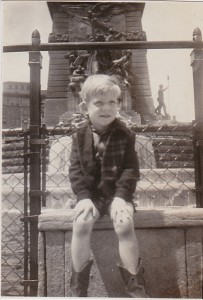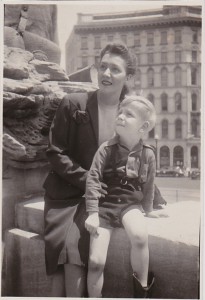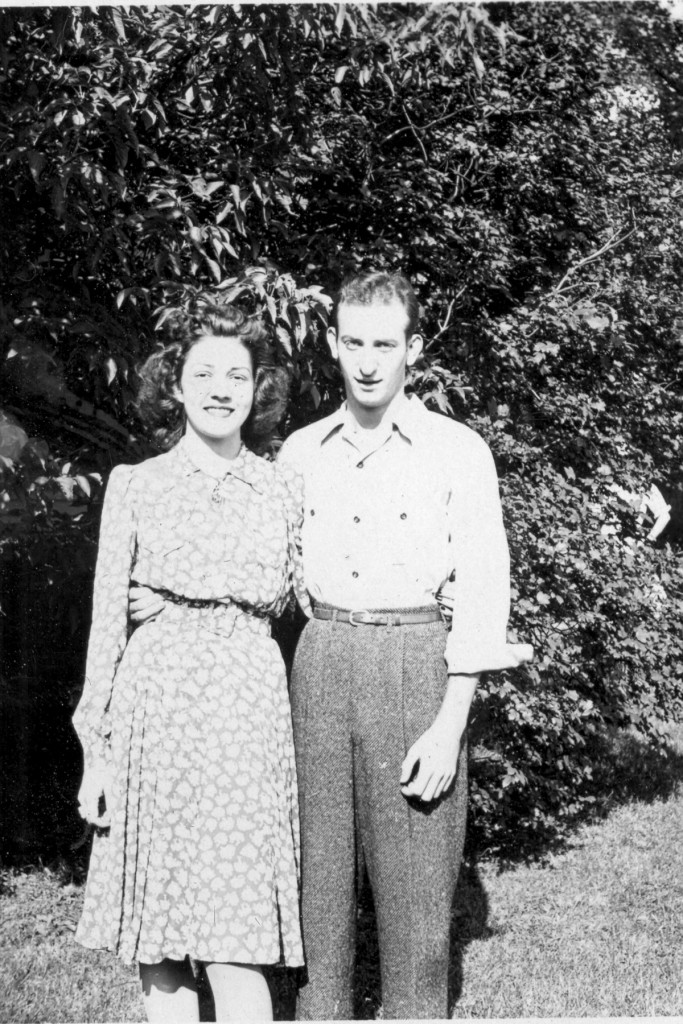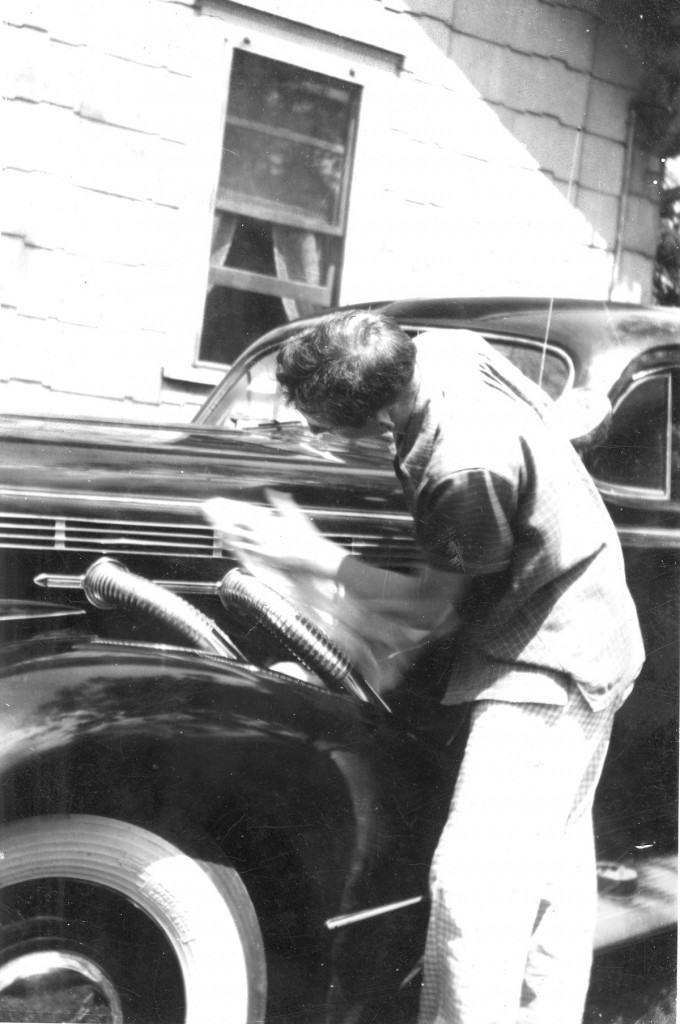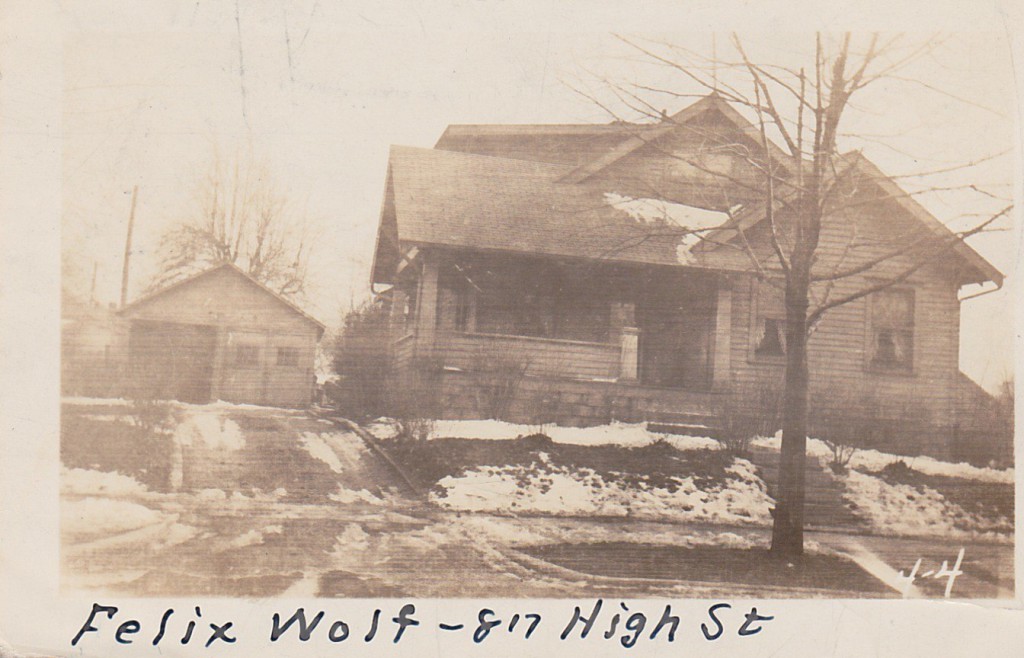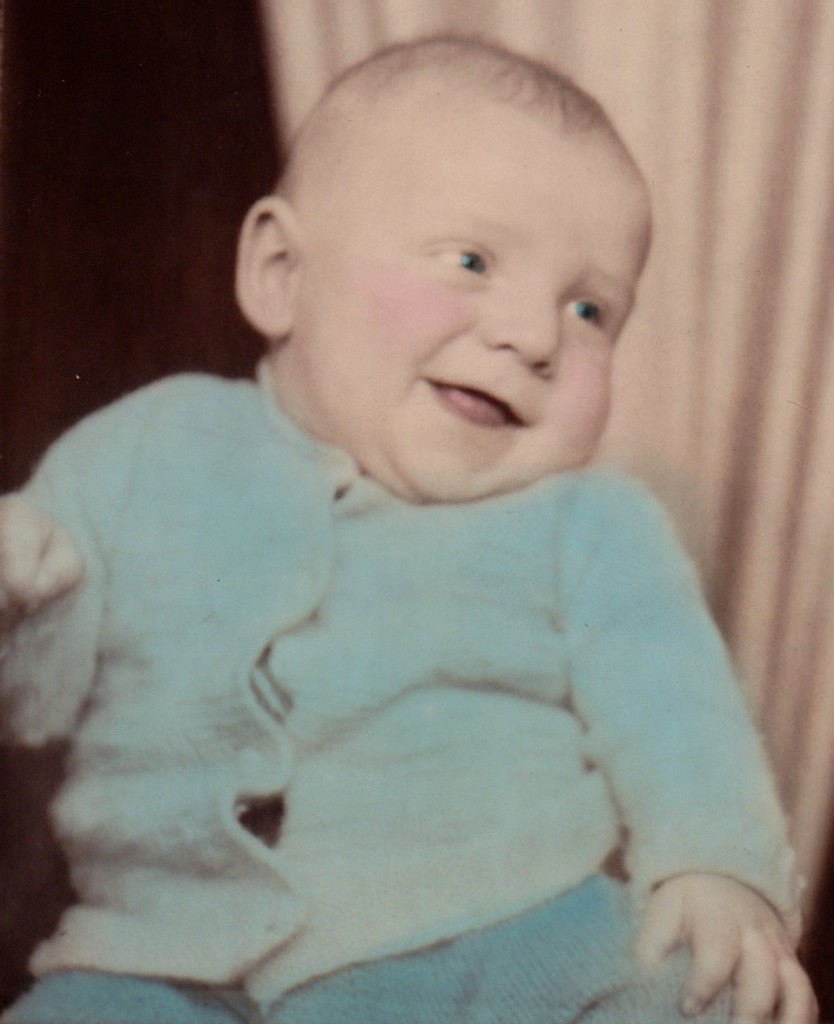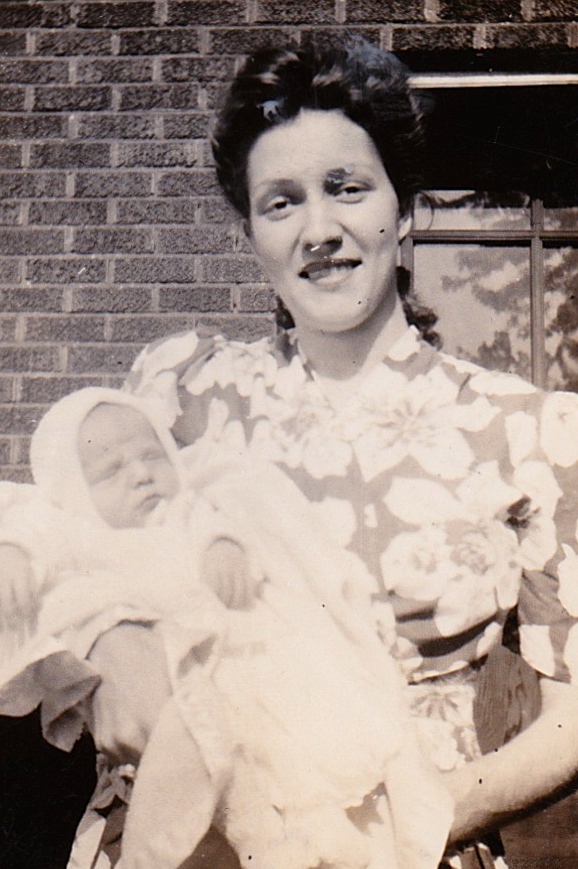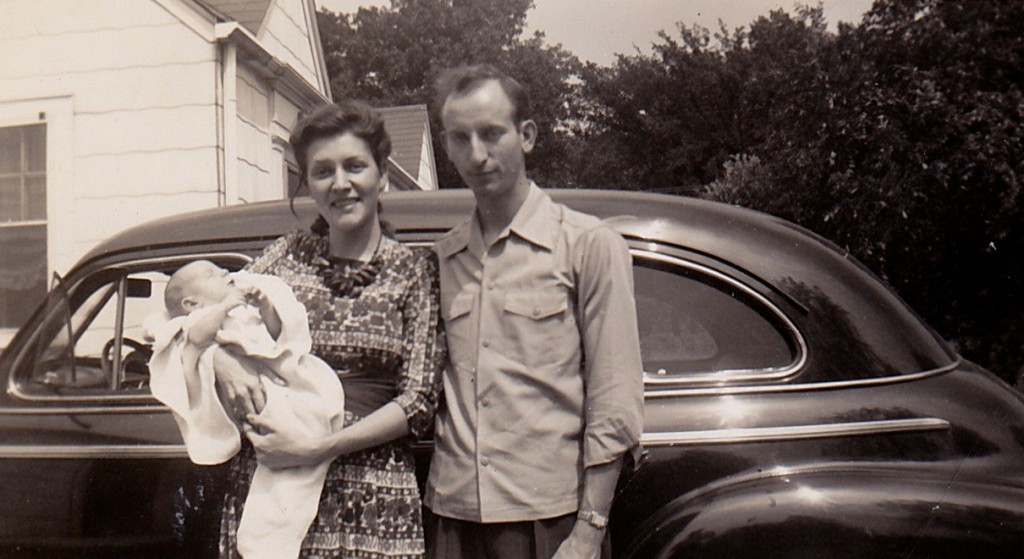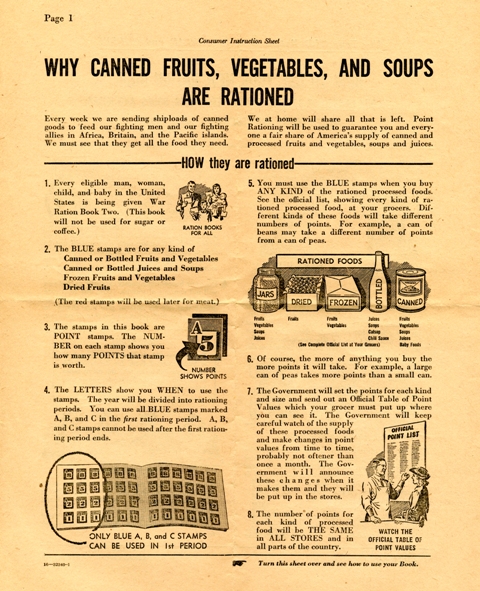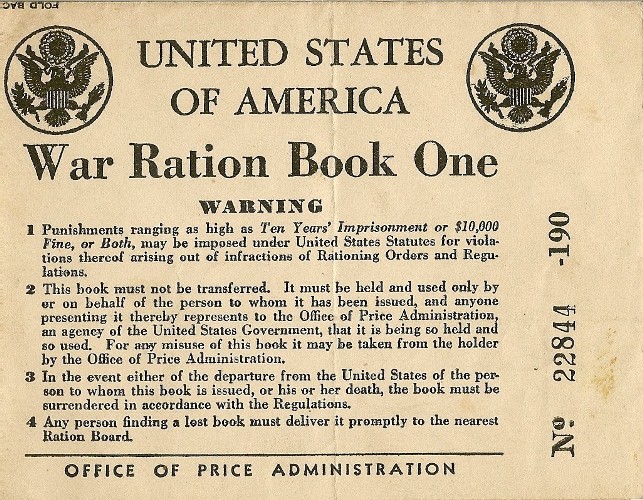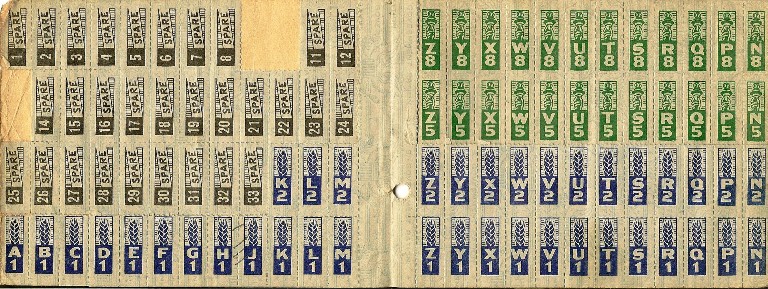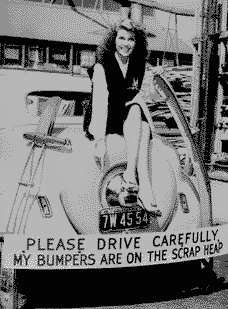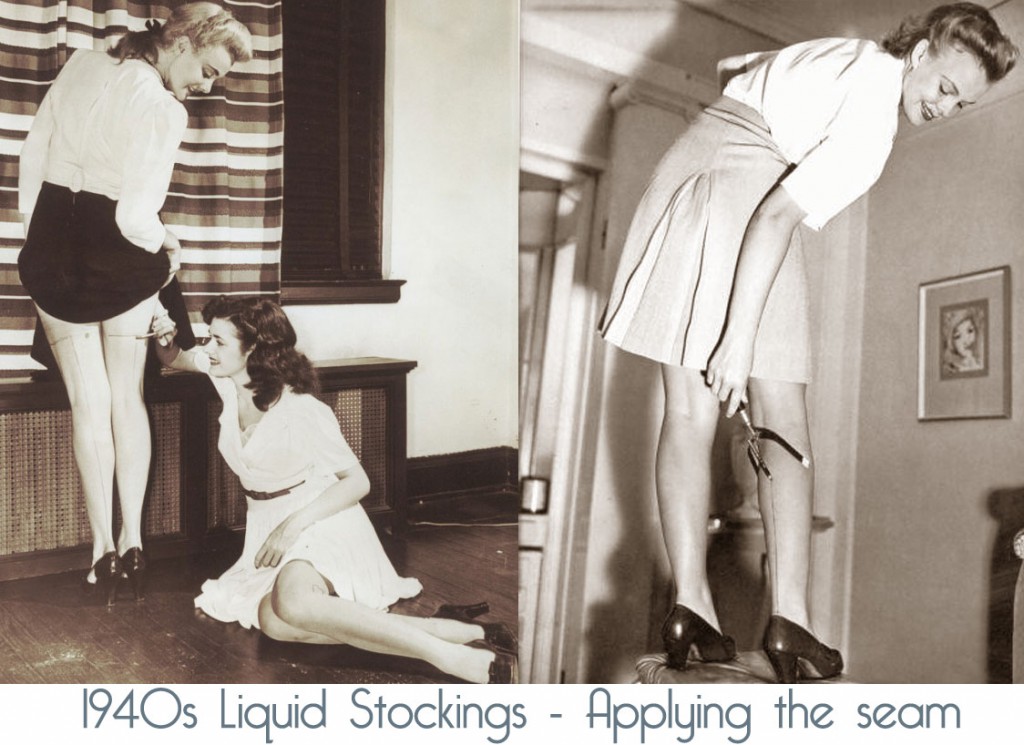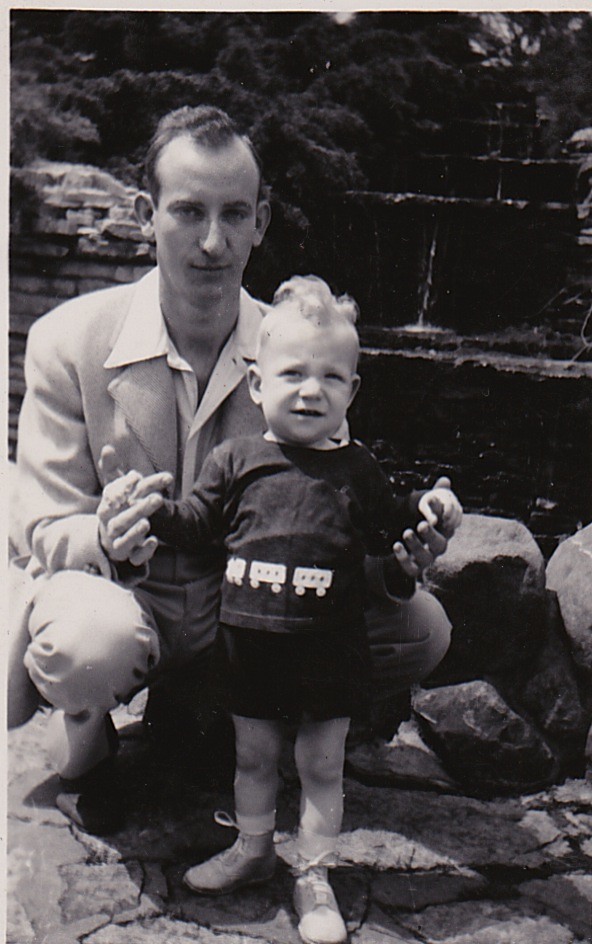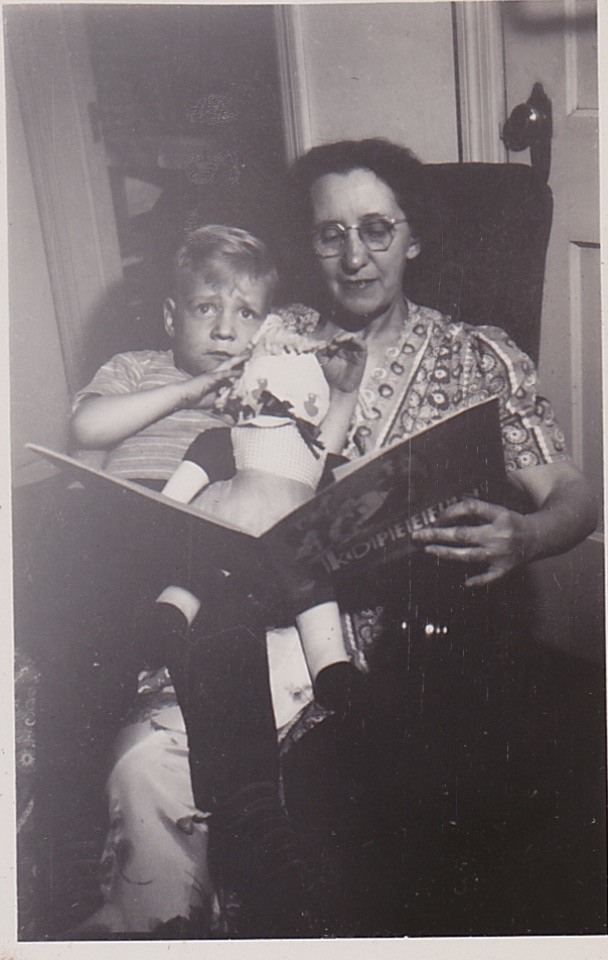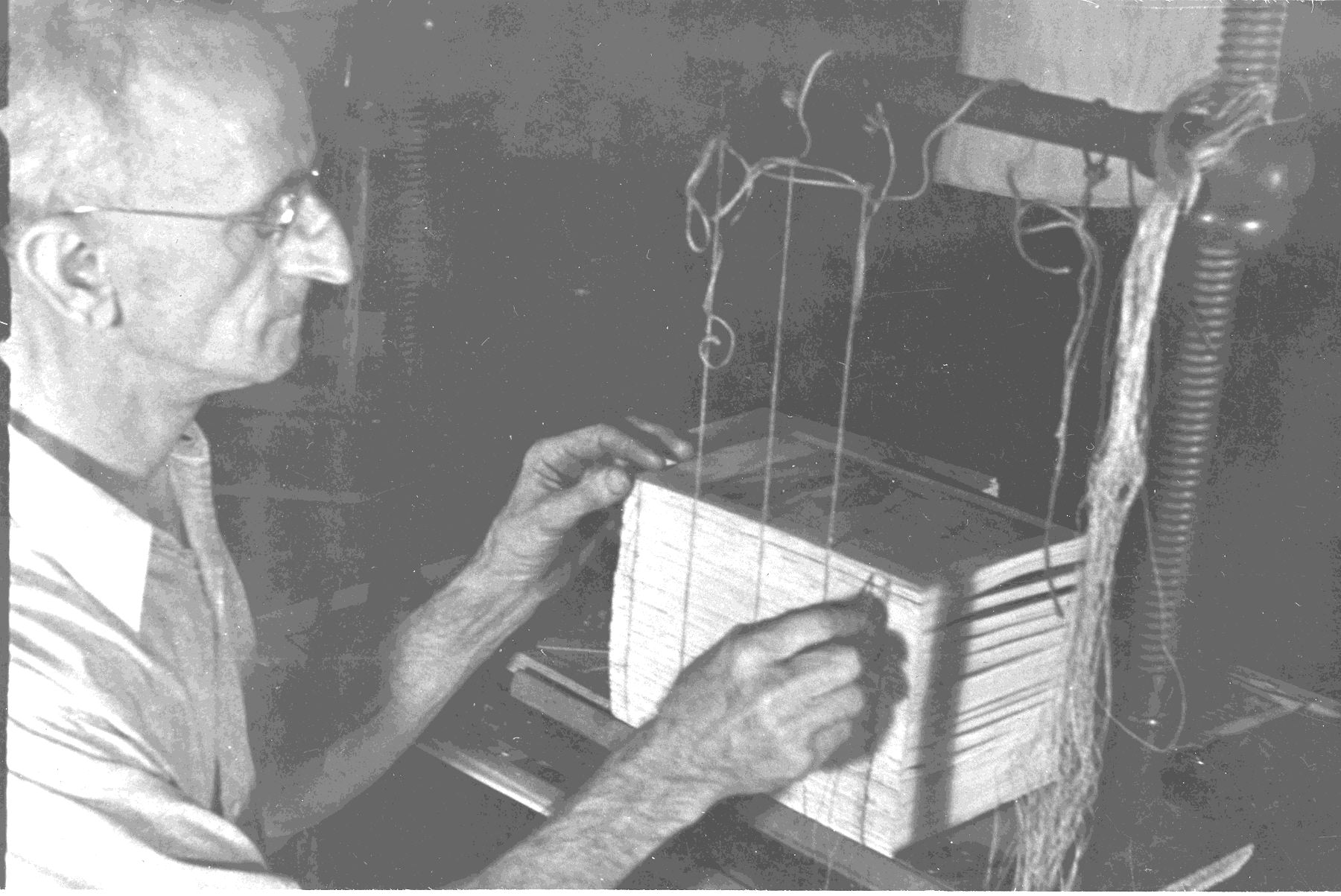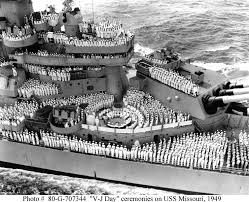I WAS LUCKY TO BE ALIVE!
Soon after the wedding, Mother began to have medical problems. After many consultations and tests the prognosis was, “Having children may be impossible.” The doctors advised, that if Mother and Dad wanted a child, they had better start trying immediately! After many months of “trying”, it was confirmed that Mother was miraculously pregnant!
The family doctors were located in the Chicago Heights area, which, necessitated long drives from Anderson in the 1941, blue, Nash 600, which they had bought from Dad`s brother, Leopold.
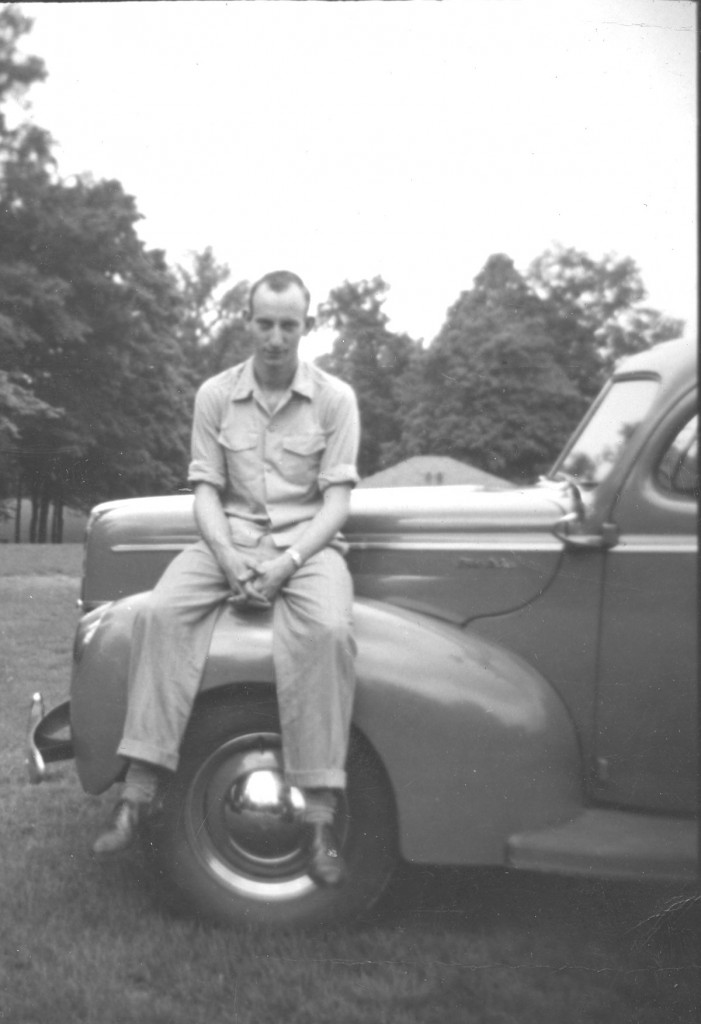
The1937, straight 8, maroon,Pontiac, 2-door which was Dad`s pride and joy when they began dating, had to be replaced with a more reliable car for these trips. Dad used to joke that it took 10 gallons of gas and 10 quarts of oil to make the trip. While dating, they had installed chrome supercharger side pipes, several different horns, a big spotlight and a constantly hand-waxed shine! Dad wired each horn to it`s own separate push button on the dash and when they went thru the old Brown Street tunnel in Anderson, Mother held down all the buttons at once! I bet the neighborhood loved that!
On one such trip to have her check-up, the doctor had them come into his office for a consultation. The news was not good. X-rays and tests revealed the fetus was resting on and putting too much pressure on the spine. The prognosis was a very likely possibility of paralysis if the baby were to be carried to full term! The doctors recomended terminating the pregnancy. But, If they decided to go forward, it would require bed rest and a lot of care with the chances of her never walking again!
After discussions with Grandma and Grandpa Barrett, Mother and Dad had a very long drive home to Anderson. They were both working at the GT and living in an upstairs apartment at Grandma and Grandpa Wolff`s on High Street.
After a few days of discussing their wants and options, it was decided that this was their only chance to have their very own child and they would both be willing to live with the consequences. This decision meant some drastic changes had to be made in their lives! First, Mother could not keep working. Second, the upstairs apartment would not be an option. Third, the doctors and her Mother`s care were up North.
So, after making the toughest decision in their lives, they had to come up with some tough solutions to the problems at hand. After offers of help from the families and much discussion, the choices were made. Mother would quit work and go be near her Mother when the time required it.
The United States entered the war on December 7th, 1941, and by now many of the factories were already transitioning into the manufacturing of war materials. Mother and Dad decided to check out the job market in the area near Grandpa and Grandma Barrett and the doctors.
The Continental Steel and Rolling Company plant, in that area, had already tooled up to produce steel plates and other large foundry castings, and were hiring everyone they could. So, on December 22,1941, Dad and Mother quit their jobs at the GT and Dad went to work for Continental Steel and was being trained to operate a huge vertical turning mill..
They had found an apartment in Hammond, Indiana that would be very convenient, since St. Margaret`s Hospital was there and everyone was close by.
As the months went by, Mother got weaker and it wasn`t long before total bed rest was required, due to a partial paralysis of her legs! In March, Grandma Wolff came up by train to help Mother and ended up staying for three weeks.
About this time, Harry James, a big band leader, recorder a song that became very popular. Mother and Dad adopted it as their private “theme song”. The title was “I Don`t Want to Walk Without You Baby”!
HERE I COME READY OR NOT!
Day 1036 of the war,July 2, 1942:
In Parliament, British Prime Minister Churchill faces a vote of no confidence following the series of defeats by Japan in the Far East and now by Rommel in Libya. The proposers of the vote, Conservative MPs Sir John Wardlaw-Milne & Admiral of the Fleet Sir Roger Keyes plus National Liberal MP Leslie Hore-Belisha (previously Chamberlain’s Secretary of State for War), present a half-baked case for censure. Churchill, closing the debate, responds “if democracy and Parliamentary institutions are to triumph in this war, it is absolutely necessary that Governments resting upon them shall be able to act and dare, that the servants of the Crown shall not be harassed by nagging and snarling”. He wins the confidence of Parliament comfortably, 475 to 25.
80 miles East of Shanghai, China, US submarine USS Plunger sinks Japanese transport ship Unyo Maru No.3.
Overnight, 325 RAF bombers (175 Wellingtons, 53 Lancasters, 35 Halifaxes, 34 Stirlings, 28 Hampdens) return to Bremen, Germany, damaging 1000 houses and 4 small industrial firms (5 civilians killed, 4 injured). In the port, 3 cranes and 7 ships are damaged with 1,736-ton steamer Marieborg sunk. 8 Wellingtons, 2 Hampdens, 2 Stirlings & 1 Halifax are lost.
The Allies received word on the construction of a strategic Japanese airfield (Henderson Field) on the island of Guadalcanal! US Navy and Marine forces spring into action.
First Battle of El Alamein. Rommel tries the same tactics with the same result. 90th Light Division fails to make progress against the coastal “El Alamein box”, again stopped by British artillery and RAF bombing. 10 miles inland, 15th and 21st Panzer Divisions are stopped by “Robcol” (field artillery, light anti-aircraft guns and an infantry company under Brigadier Robert Waller) which occupies the dominating high ground at Ruweisat Ridge. In late afternoon, British 4th and 22nd Armoured Brigades attack both Panzer Divisions and drive back the German tanks, capturing 2,000 prisoners and 30 field guns
Mother had been bed ridden with paralysis of the legs for months, and on this day, it was decided that the time had come to perform a c-section. I was born at St. Margaret`s Hospital in Hammond, Indiana. At 8 lb.. 8 oz, and 22 in. long, I was pronounced a healthy baby, but, ….Mother was still paralyzed!
It would be another agonizing nine days of physical therapy before she would be released to go home, but, she could miraculously now walk!
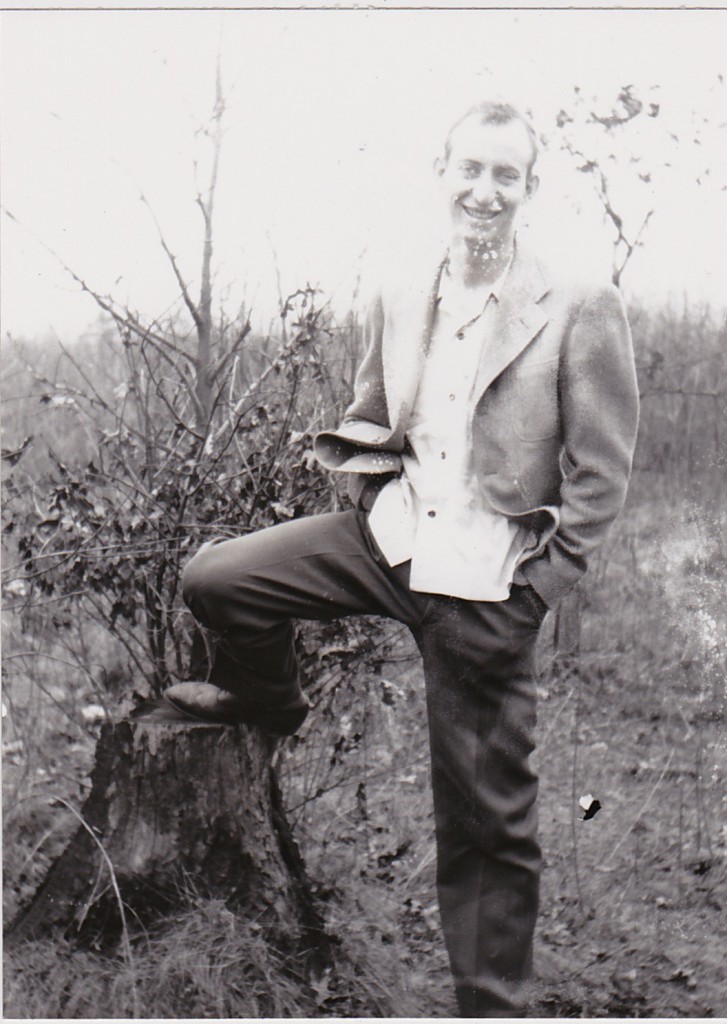
CHANGING JOBS AND HOUSES STARTS TO BE NORMAL!
With Dad still working at the Continental plant, and Grandma nursing Mother back to health, things started to settle back down to normal chaos. Mother`s Border Collie, Lyndo, took to me and performed his normal nurturing instincts and became my personal Nanny Lyndo!
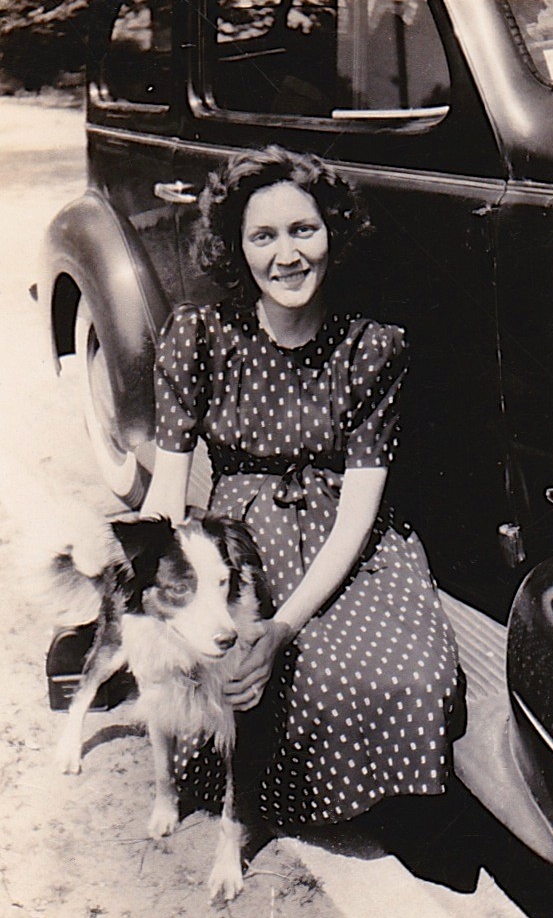
Grandma Wolff came up by train to visit and help out quite often. During one of these visits, she noticed Dad was loosing weight (something mothers are always prone to notice and make comment) and had bruising and burns on his arms and legs! Dad acknowledged he had been having problems with the conditions at work but, didn`t want to make a fuss. It turned out (no pun intended) that the hot turning shavings, coming off the machined castings, were very thick and had to be broken with a metal rod to keep the spiral shavings from tracking down the aisle and tangling into something or someone! Each time Dad had to “break” the hot shavings, they would whip back and hit his arms or legs with no protective gear. So, after seven months of this, they decided on July 23, 1942, that it was time to return home to Anderson. And, on July 30th Dad started to work with Delco- Remy.
They rented the back apartment from Grandpa Wolff while Mother was still recovering. Grandpa and Grandma`s house was large, with an upstairs and basement. Grandpa, being a very frugal and practical person, decided it was a waste of space, what with the boys grown up and married, not to utilize it for income. So, during the depression, he added a bath and kitchen to the upstairs and a bath to the back of the house. Little did he know that the boys would be his tenants for the next several years!
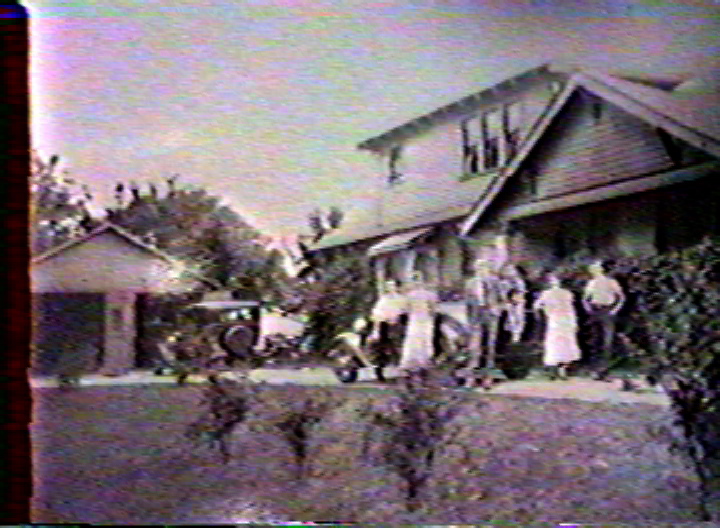
I regress, but,… this photo with the model T Ford in the drive reminds me of a story that my Uncle Bill, Dad`s brother, shared with me one day. It goes that on a rare day, when Grandpa Wolff drove the “T” to town with Uncle Bill, they were returning home. Driving up College Drive toward High Street, they encountered a funeral procession coming East on High Street toward the East Maple Wood Cemetery. Grandpa slowed and stopped on the College Drive incline. Setting the parking brake and removing his hat, they waited for the procession to pass. When all was clear, he disengaged the brake and let out the clutch while trying to go up the incline and immediately stalled the engine. Resetting the spark and the emergency brake, Grandpa waited while Bill cranked the engine back to life. Again, releasing the parking brake and easing out the clutch, the engine was again stalled. Grandpa set the parking brake, and without saying a word, got out of the “T”, latched the door shut and walked home. He never drove again!
OK, back to 1942. With Dad working at Delco and Mother getting her strength back, we had lots of time together. Grandpa and Grandma Barrett came down from Chicago Heights, Illinois every chance they got.
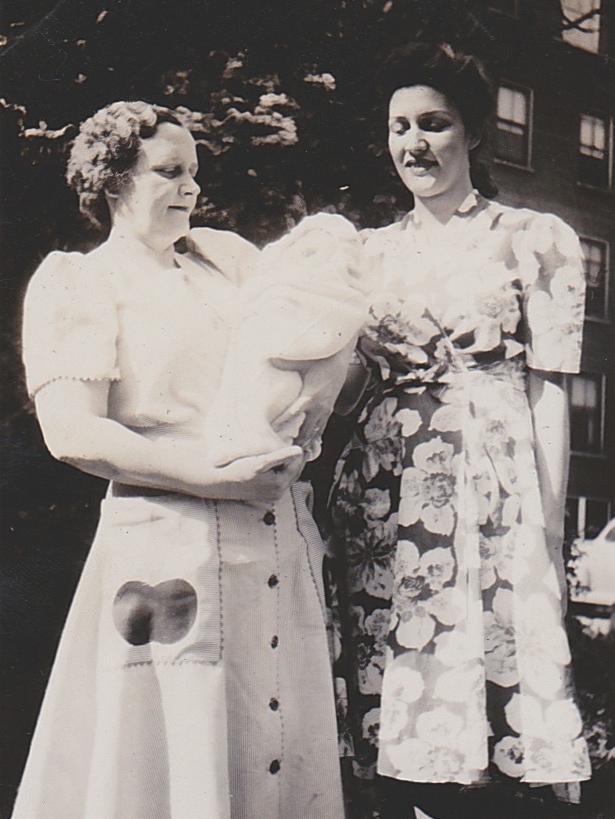
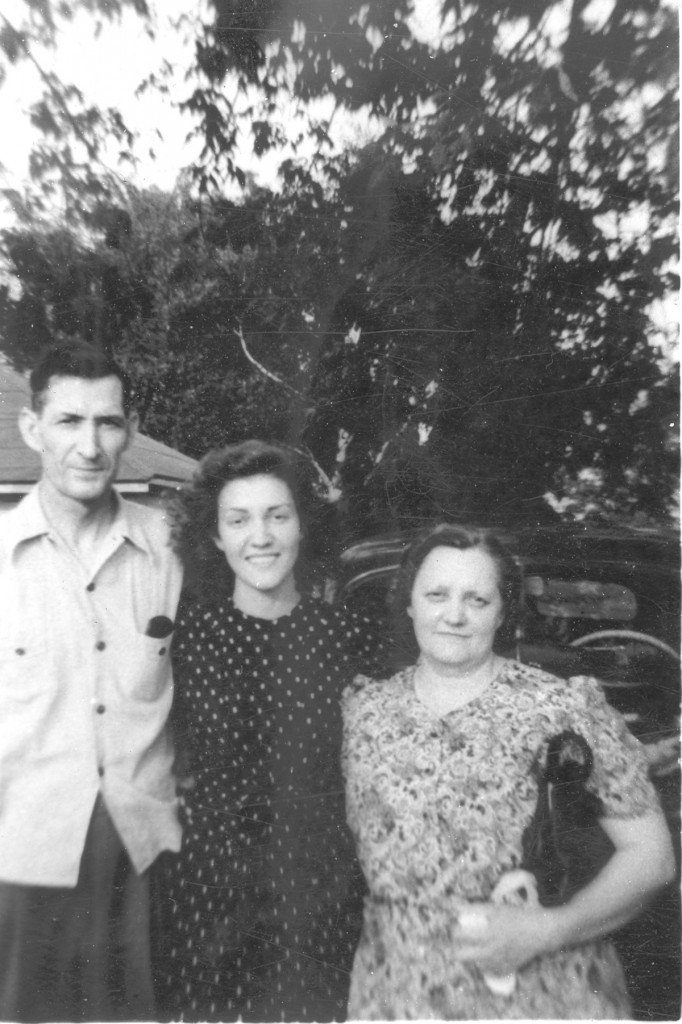
Mother gave me my first ride in my little red wagon!
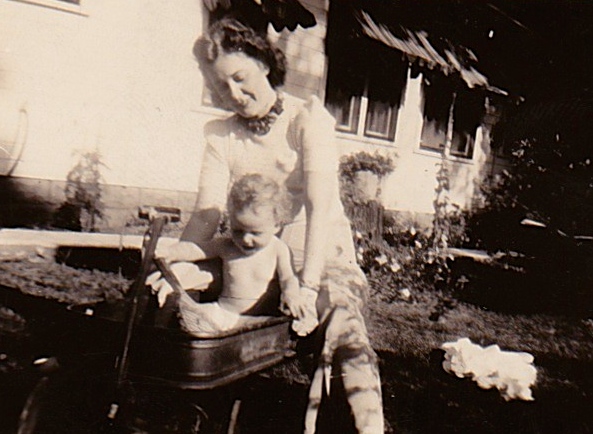
Before we knew it, our first Christmas was here! Dad picked out a Christmas tree that touched the ceiling of the back apartment and this “big tree tradition” would be continued for as long as I lived at home! This one featured War Bonds in the branches.
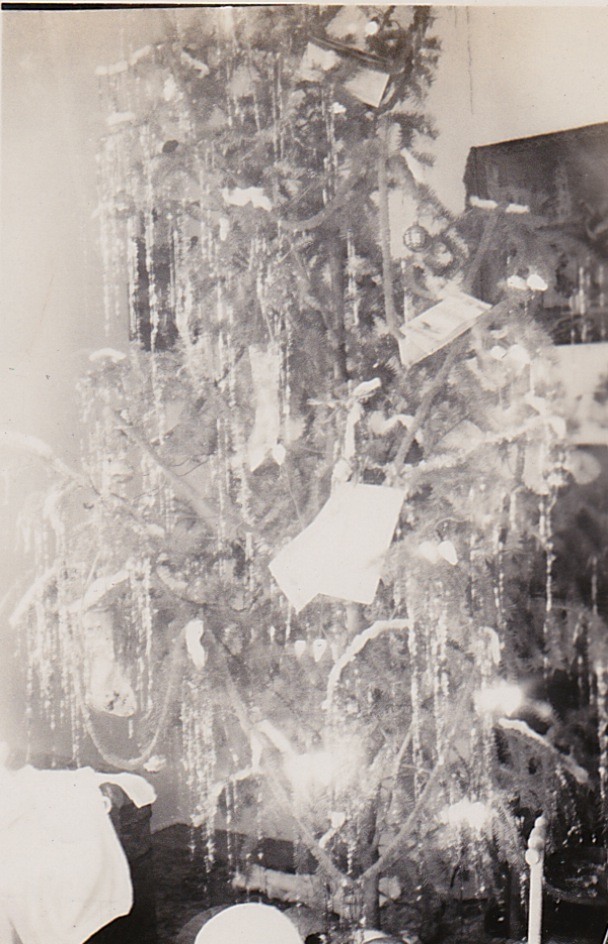
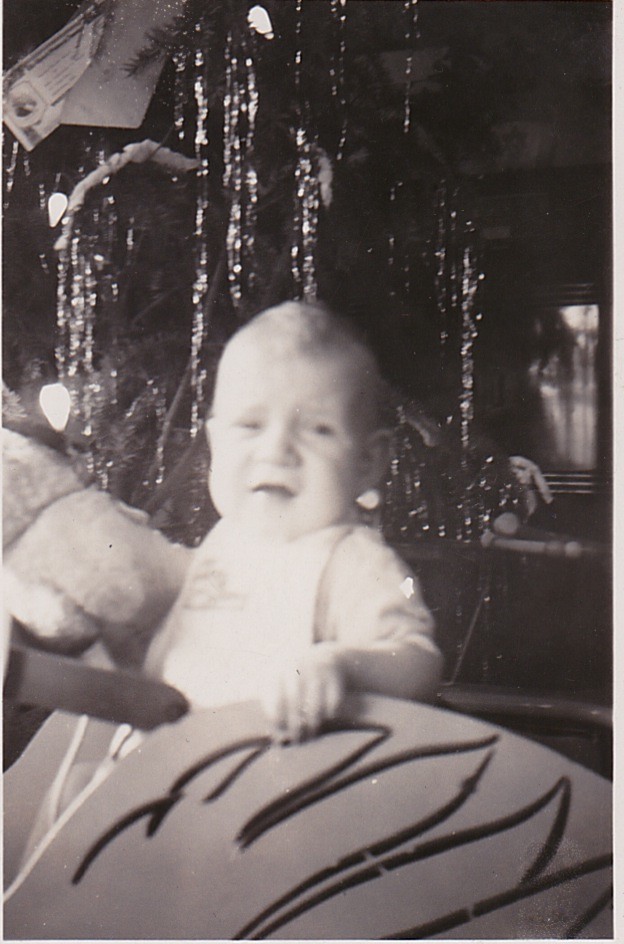
WAR RATIONING BECOMES A WAY OF LIFE.
After a short stint in the factory, Dad decided that was not the life for him and secured a job as service station manager at a local gas station which was located at 13th Street and Central Avenue in Anderson. The building is still there, though it has gone through many business changes since then, the most recent was for an automotive upholstery shop. Since it was war time and gasoline was rationed, Dad worked out a deal with the local cab company to buy all of their gas and service work at his station. Even with this extra, Dad and Mother still had to literally count pennies to pay the bills.
Grandpa Wolff`s journal on May of 1942, showed some of the affects of war rationing. “Registered for sugar rationing . Had 73 pounds on hand so did not get a book. 3 of us in the family, each one allowed 1/2 lb. per week. So, our 73 lbs. is supposed to last about 49 weeks.”
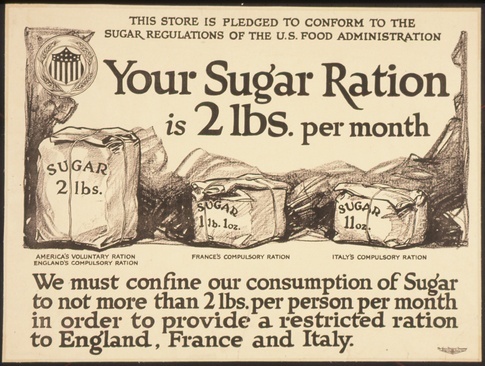
With the onset of World War II, numerous challenges confronted the American people. The government found it necessary to ration food, gas, and even clothing during that time. Americans were asked to conserve on everything. With not a single person unaffected by the war, rationing meant sacrifices for all.
In the spring of 1942, the Food Rationing Program was set into motion. Rationing would deeply affect the American way of life for most. The federal government needed to control supply and demand. Rationing was introduced to avoid public anger with shortages and not to allow only the wealthy to purchase commodities.
Rationing could be complicated. A Gallup poll in 1943 found that 53% of men and 76% of women were confident in their understanding of rationing.
The inside of a ration book containing the stamps that had to be surrendered to buy goods. Notice the number and letter sequences on the stamps. This was very confusing!
Ration books were very valuable and had to be presented to the grocery clerk. Holders like these would help protect the book and its stamps. Grandpa Wolff made holders like this for all of the family and many friends.
The rationing spread to almost every product and produce. Nylon stockings exploded into the average American woman’s life in 1939, when Dupont began manufacturing the alluring synthetic. Eager shoppers snapped up the new nylons across the country, though they were not particularly cheap in the beginning, most retailing as high as silk stockings. Demand in the USA was extraordinary and by the onset of war, Dupont could not keep up. However the advent of war brought a sudden drop in the availability of nylon as Dupont shifted into a war footing and production turned to parachutes, bomber tires etc.
Mother said she would use an eyebrow pencil to draw the Imaginary nylon stocking seam up the back of her leg to appear as though she on had nylon hose! To draw a straight line free hand is a skill for anyone to master, but on an uneven surface, it required dedication. But this was no problem to a woman who was determined to achieve knockout legs for that important dance. Women became regular Picassos with their eyeliner pencil. There were devices sold that enabled one to affect a reasonable line, but one had to be a dab hand.
INDIANA MANUFACTURING JOINS THE WAR EFFORT.
As Mother got stronger, and was getting around just fine, she applied for a secretarial position with the Anderson Chamber of Commerce. She started work the next week as a correspondence clerk, (mail sorter). The “Chamber”, as it was referred to then, was the starting point for almost all inquires concerning business and war related industry. As such, Mother came across postage stamps from all over the world and I think this is when her philatelic interest began.
This paragraph is from the “INDIANA MAGAZINE of HISTORY”. Click on the link below for more information on Indiana during WWII.
“First of all, the war offered some proof that the proud boast “INDIANA—The Center of Almost Everything” is not simply Chamber of Commerce propaganda but reasonably demonstrable fact. Whether because of her geographical location at the center of population, her unique combination of distance from the coasts but proximity to markets, her natural resources, her transportation network, her skilled labor, her diversified industry, her educational system, the skill of her politicians, or a judicious mixture of all these
factors, it is certainly apparent that Indiana was attractive both to military officers planning the location of key installations and to governmental officials searching for the placement of war contracts.”
Click on the link for more history of Guide Lamp in WWII.
During that time, Anderson had many factories that were producing military materials. Guide Lamp produced lamps which were installed on military vehicles along with brass anti-aircraft shell casings.
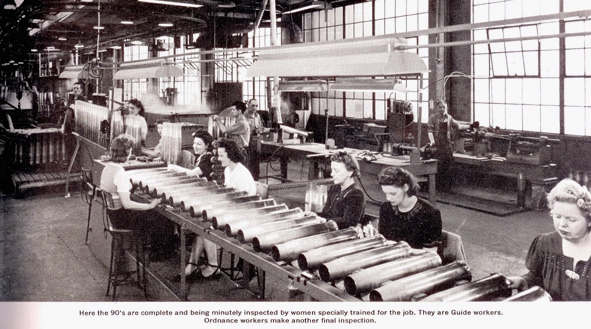
They also produced sheet metal stamped hand guns, called The Liberators, which were dropped behind enemy lines in Europe for the resistance fighters to use. Also produced, were the fully automatic machine gun, nicknamed “the grease gun”, because it looked like the cartridge that was filled with grease in the grease applicators (guns).
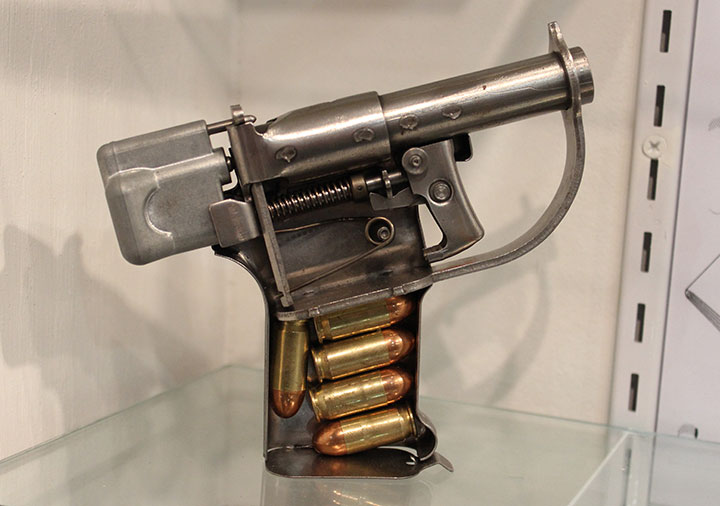
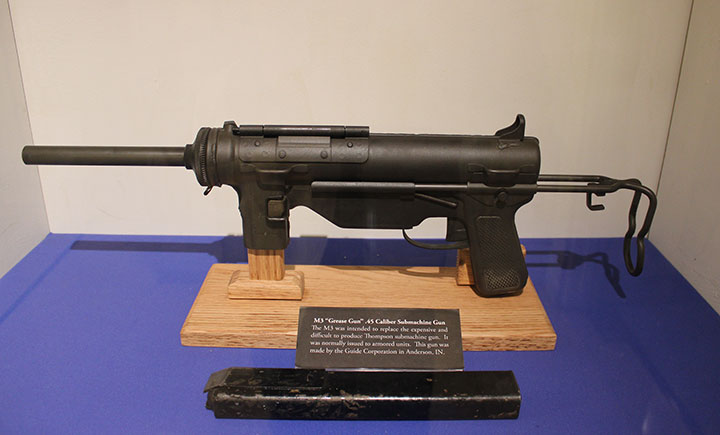
Guide Lamp World War Two / WWII Production Numbers / Statistics: (8,500,000) total of headlamps, tail lamps, dome lamps, blackout lamps and signal lamps; (3,400,000) Stimsonite reflector units; (22,000) Bell Aircraft P-39 Airacobra spinner noses; (1,000,000) water jacket sleeves for Allison aircraft engines; (36,750,000) cartridge cases for 37mm, 40mm, 90mm and 105mm constructed of both brass and steel; (1,600,000) .50 caliber Browning machine gun barrels; (682,163) complete M3 and M3A1 submachine guns.
The M3 Submachine Gun:
1943 – 85,130 M3
1944 – 343.372 M3
1945 – 178,192 M3
1945 – 15,469 M3A1
Total Production of M3 – 606,694
Total Production of M3A1 – 15,469

Guide Lamp and Delco Remy both received the cherished “E” Flag for their outstanding contribution to the war effort!
The following articles show some of Delco-Remy`s contribution to the war effort. Click on the link below for more information about Delco-Remy`s role in the war.

Delco had to convert many of its` plants to meet the requirements of the War Department.

Quality control was vital to the safety of the service men relying on the dependability of the parts produced for their equipment! Below is one such inspection line for the magneto used on many engines.
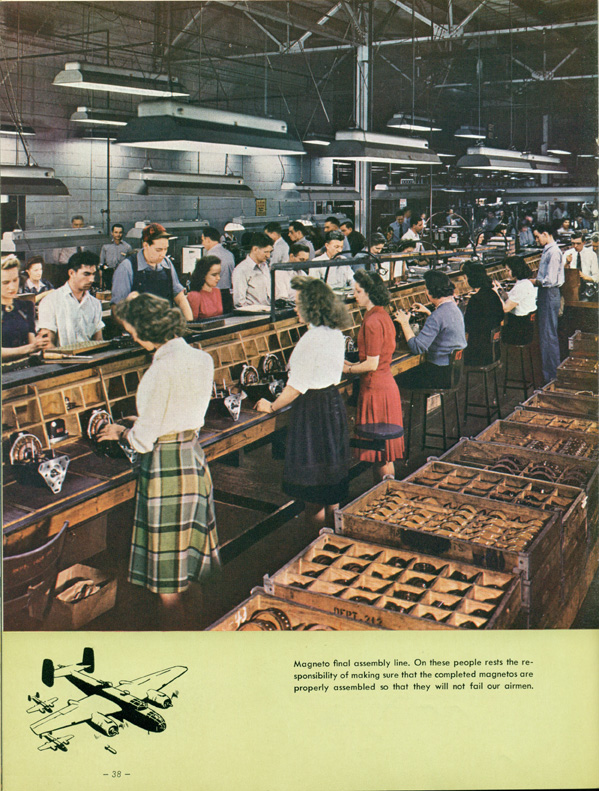
Receiving the coveted Army/Navy “E” flag drew quite a proud reception. Guide and Delco would continue their production quality and receive stars to add on the flag!
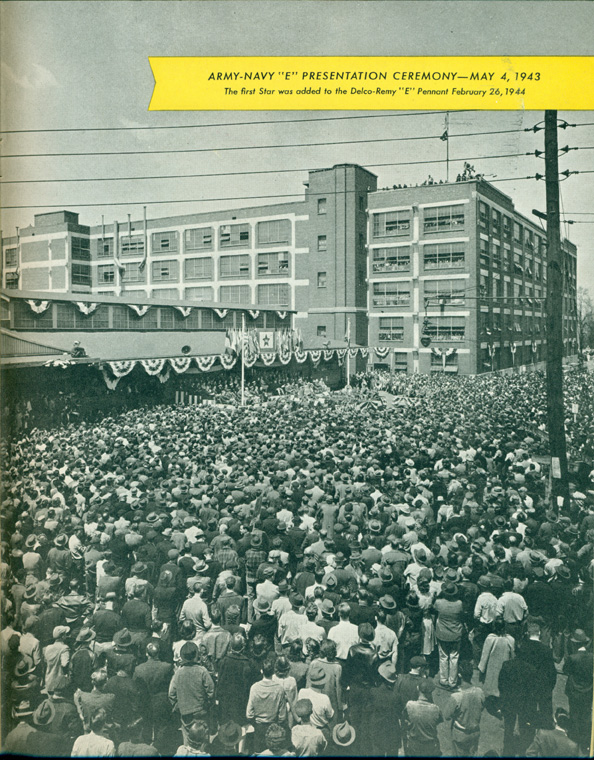
Delco-Remy World War Two / WWII Production Numbers / Statistics: Electrical Components for Military Trucks – Generators and generator regulators, starting motors, ignition distributors and coils, switches, and batteries; Electrical Components for Military Tanks and Armored Vehicles – Generators and generator regulators, starting motors, ignition distributors and coils, apparatus boxes, and batteries; Electrical Components for Military Aircraft – Generators and generator regulators, magnetos, and batteries; Automatic Aircraft Engine Controls; Solenoids for Sperry Autopilots; Automatic Trim Tab Controls; Electrical Components for Military Marine applications – Generators and generator regulators, starting motors, ignition distributors and coils; Marine propeller pitch controls for landing craft and submarine chasers; Marine diesel equipment – pistons, blowers, pre-heaters and pre-heater fuel pumps, governors; Tubing – for electrical, fuel, brake, air conditioning, oil and air lines; Allison V-1710 engine castings – Various; Aircraft engine machined parts – Various; (1,000,000) 20mm shell bodies; Various solenoids for starting motors, aircraft bomb release racks, guns and overdrive controls.
Delco-Remy was one of 17 General Motors Divisions that provided parts for the Boeing B-29 program during the war. Costing more than any other project during the War, including the Manhattan Project, the B-29 “Superfortress” was the most advanced and complex aircraft produced during that period.
May 1943, showed progress in the Atlantic theater of operations.
1943
Saturday
May 1st – May 31st
By the end of May, 43 U-boats are sunk to just 34 merchant vessels.
1943
Saturday
May 1st
Allied aircraft are fitted with U-boat detecting radar systems.
1943
Sunday
May 16th
RAF bombers make their most famous raid of the war to date – this through Operation Chastise – as 19 Lancasters attack the dams at Mohne, Eder, Sorpe and Schwelme supplying power to the Ruhr industrial sector. 9,000lb bouncing mines are used in the successful attack.
1943
Wednesday
May 19th
Some 33 U-boats assail an Allied convoy. However, the streamlined Allied response nets zero ship losses and fatalities. The U-boats come up empty.
1943
Monday
May 24th
Due to dwindling results, German Admiral Karl Donitz calls back his U-boats from operations in the Atlantic.
I HAD NO IDEA ALL OF THIS WAS GOING ON IN MY WORLD.
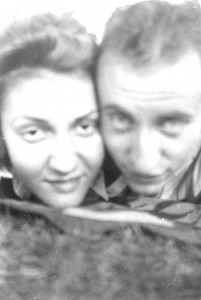
Hey, you kids with your smart phones think you started the selfie photo ,the texting acronyms and the music playlists? Well, LOL! Mother and Dad took this selfie in 1941 with a Kodak Box camera! Dad created playlists in 1941, when Mother would be up North with Grandma Barrett. Back then music was recorded on large 98rpm, lacquer records, with a round label affixed to the center of the disk, identifying the performer and song title. Dad would cut out round, white, blank, labels and glue them over the original. On these, he would write, “PLAY FIRST”, “PLAY SECOND”, etc. and mail the records to Mother. And as for acronyms, the military and private industry came up with quite a few, like: SNAFU, situation normal all fouled up and FUBAR, fouled up beyond all recognition. Of course, other four letter “F” words could be inserted, depending on the absence of or presence of the female gender!
1943
Friday
July 9th
The Allied invasion fleets sail out to Sicily.
1943
Saturday
July 10th
US 82nd Airborne Division and British 1st Airborne Division paratroopers land at strategic locations across Sicily prior to the invasion force’s arrival.
1943
Saturday
July 10th
Operation Husky begins. Target – German-held Sicily. Some 2,590 naval vessels take part in the invasion which encompasses two army groups of American and British forces invading at two different coasts of the island.
1943
Saturday
July 10th
Soviet resistance to the German offensives is so intense that German General Hoth is forced to bring up his reserves and commit them to the fight. The advancing Germans are slowed evermore by the stinky Soviet defenders, also made up of deadly anti-tank teams.
June 1943, and we had now moved again. This time to the larger upstairs apartment on High Street. Many lunch times and week ends were spent at the Shady Side Memorial Park in Anderson.
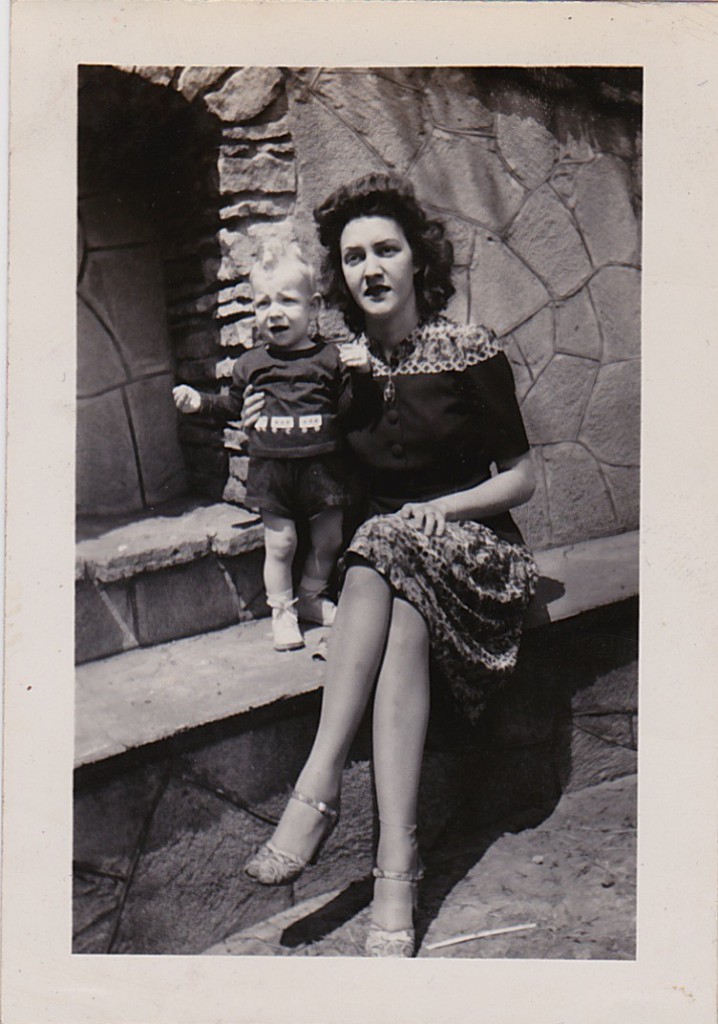
These shots were taken May 24, 1943, while I was in quarantine for whooping cough! I don`t know the dates, but, twice between now and 1945, I was hospitalized with pneumonia at Saint John`s Hospital in Anderson.

My only recollection of the ordeal, was the Sisters giving me penicillin shots in the butt several times a day. About this same time, it was determined that I needed my tonsils removed. This was also performed at Saint Johns and my only memories are of Sisters with ice cream and nightmares from the odor of chloroform. I would go on to contract mumps, measles and chicken pox. I believe that this natural immunization could be what keeps me from getting colds, flue and headaches today, just a thought!
In August, we went to visit Grandpa and Grandma Barrett and Grandpa`s sister Flora was also there for a visit. She took one look at me and nicknamed me “possum jaws” because of my poochie cheeks! Speaking of nicknames, Mother and Dad called me Skippy because I was the skipper of their ship. Grandpa Wolff always called me by my middle name, Eugene. Mother tried getting me to say Skippy Gene, but I could only manage Pippy Dene, and another nickname was born! Later, when I was enrolled in school, my name was Gene Wolff….gee another name? More about the repercussions of all these names will surface in a later period.
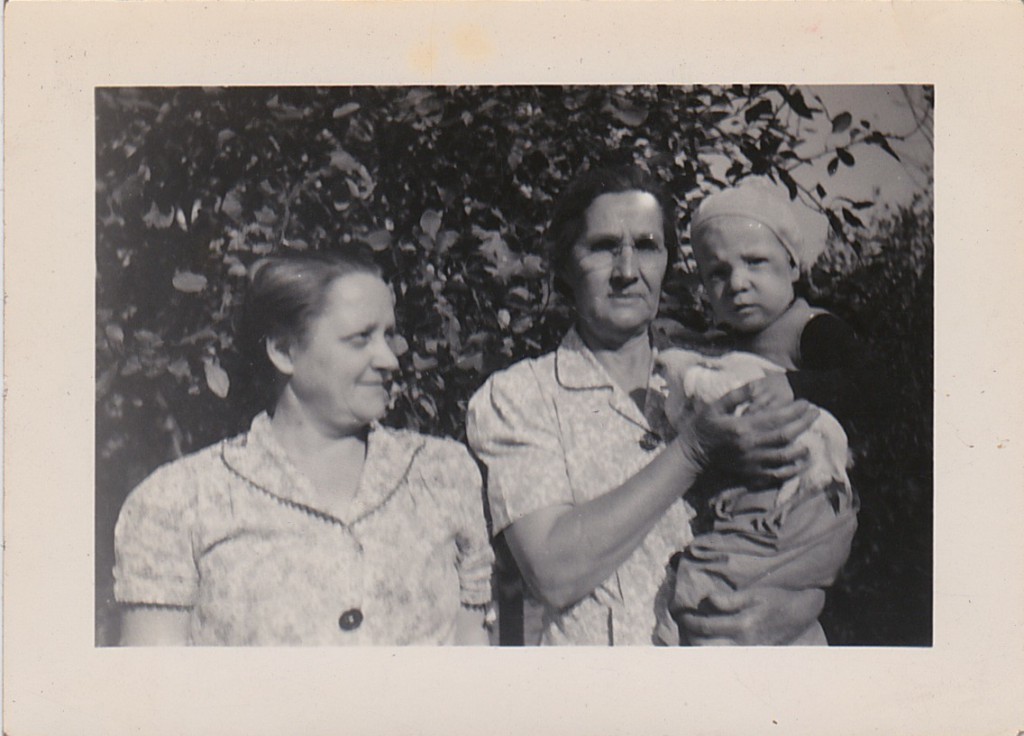
Soon another Christmas was upon us and another tall tree with war toys! This was in the upstairs apartment.
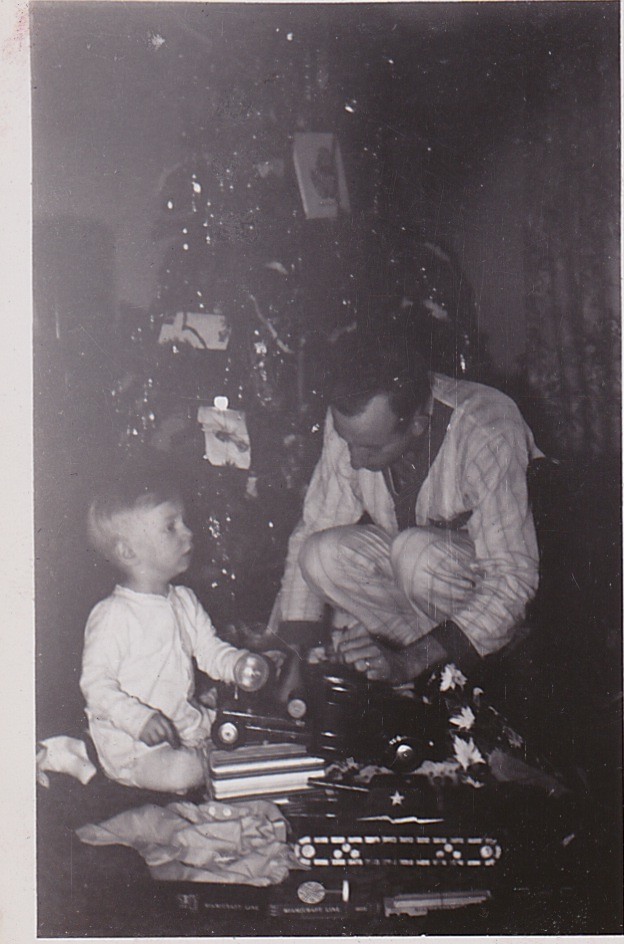
I liked to have a ball of cotton between my fingers to rub my nose when I sucked my thumb.
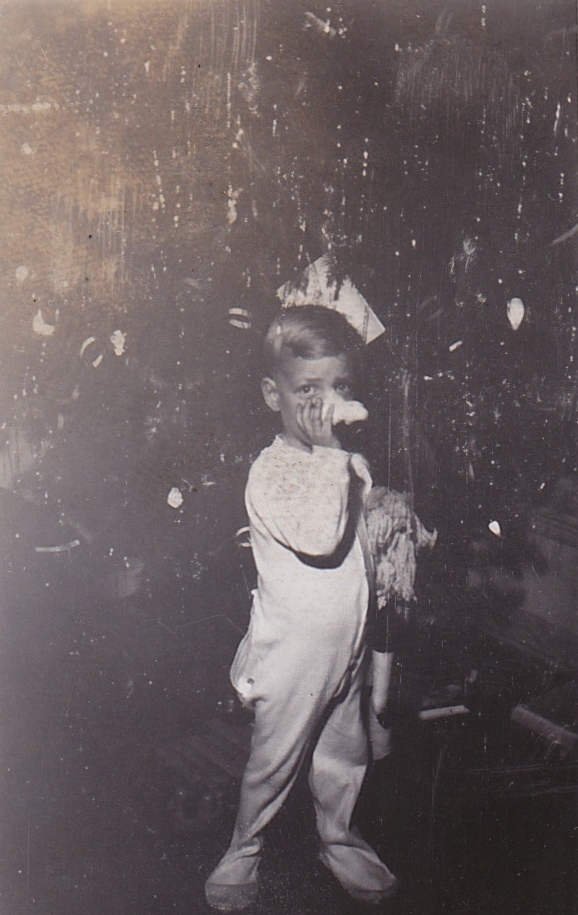
1943
Wednesday
November 10th
The combined force of US Army and Marine Corps troops numbering 35,000 personnel heads towards Betio on the Tarawa Atoll.
1943
Saturday
November 13th
US Navy warplanes and warships begin the bombardment of Japanese positions at Makin and Tarawa in preparation for the planned amphibious assaults.
1943
Saturday
November 20th
At 9:10AM, the first US Marine soldiers make it ashore at Betio during the initial amphibious landings. Nearly half are cut down in low waters by the waiting Japanese defenders.
MOVING AND JOB CHANGES AGAIN
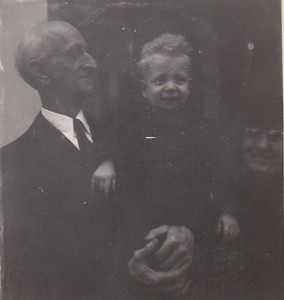
The spring of 1944, brought more adjustments to our lifestyle. The gas station was not providing much income, with the rationing and all, so, Dad decided to give the war plants another try. This time the Dodge Plant in Chicago, Illinois.
The Dodge Chicago Aircraft Engine Plant was a World War II defense plant that built the majority of the B-29 bomber aircraft engines used in World War II.
The plant design was initiated by automotive plant designer Albert Kahn and his company. The plant is seen as an influential design landmark of American industrial manufacturing facilities. The main building of the Dodge Chicago plant covered eighty-two acres and occupied over 30 city blocks and at the time it was the largest building in the world. Albert Khan had extensive underground tunnels dug as to facilitate foot and supply traffic. These tunnels span the width and breadth of the plant in a tic-tac-toe pattern. As characteristic for industrial plants of the day, wooden block floors were placed for ergonomic reasons.
The B-29 Superfortress Bomber was used in the strategic bombing campaign of Japan. It was the largest American aircraft to see service in World War II. Each B-29 Superfortress utilized four of the massive Wright R-3350 – Cyclone 18-cylinder 2,200 horsepower (1,600 kW) engines built at the Dodge Chicago Plant. There were nearly 4000 of these aircraft produced when the B-29 was retired from service in the 1960s. which made it a most labor-intensive operation.
Mother also got a job at the plant as a recording secretary which took notes and records of engine test results and wrote up the reports. We rented a duplex apartment in Munster, Indiana and got moved in in time for Easter and my second birthday.
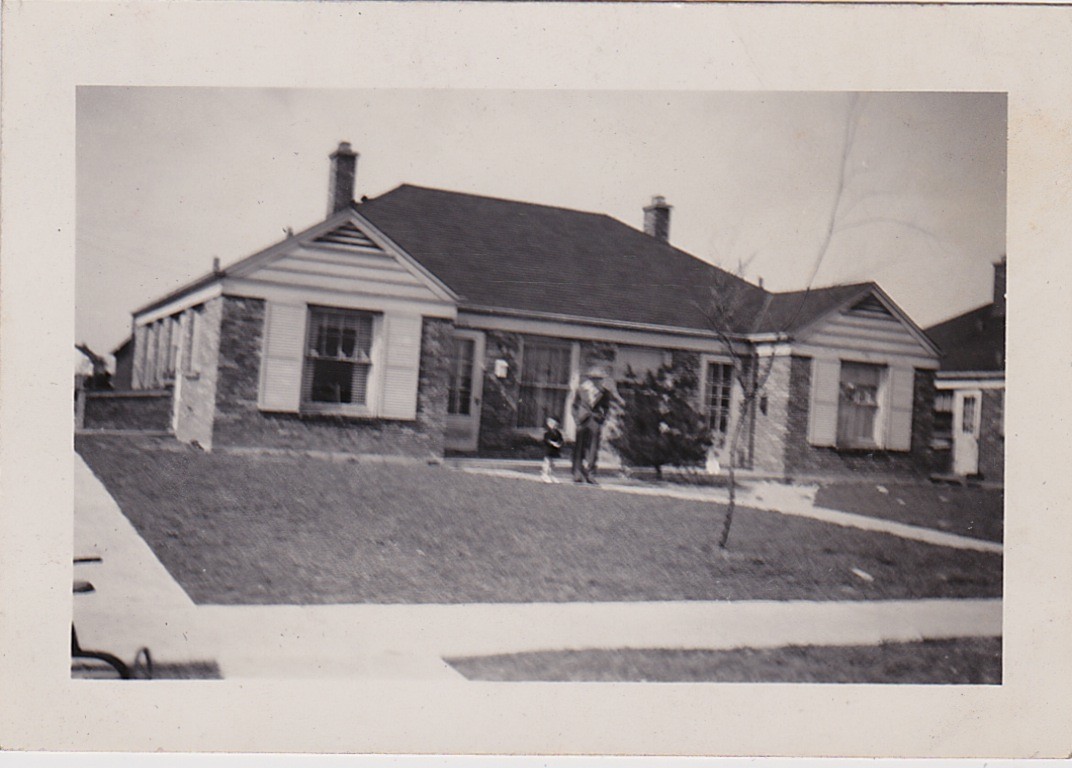
The “Skipper of the ship”!
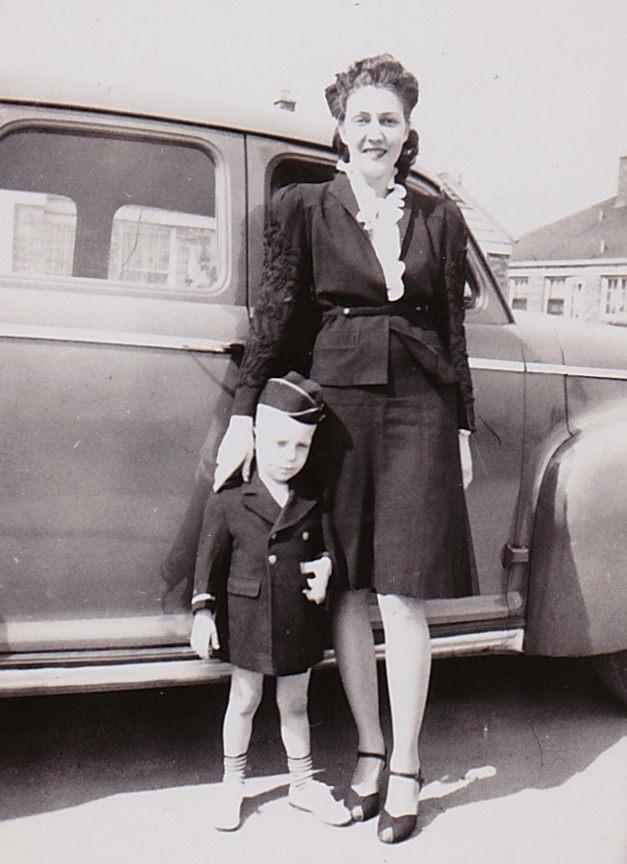

D-Day June 6, 1944
1944
Tuesday
June 6th
Some 6,000 naval vessels depart from the south of England towards France.
Allied naval warships open up with their guns on German defensive positions along the French coast.
The Canadian 3rd Infantry Division makes its way towards Juno beach. The German defenses, heavy seas and underwater obstacles cause a loss of 30 percent of the landing craft. The onshore result is equally grim as the Canadians are assaulted by the prepared Germans.
By 8:00AM, most of the German defenders at or near Gold and Sword beaches have been cleared or are on the run.
The British 50th Division pushed some 6 miles inland.
British and French special forces elements out of Sword beach connect with the British paratroopers holding the key bridges over the Orne River.
The combined British and Canadian forces at Gold face little opposition and claim their objectives with little incident.
At approximately 7:25AM, forces of the British and Canadian armies wade ashore at beaches codenamed Gold and Juno.
The US Army forces arriving at Omaha beach face a prepared, stout and veteran defense made possible by the German 352nd Division. After 2,400 casualties, the 1st US Infantry Division holds a beachhead.
The British 3rd Division arriving at Sword beach face a stouter German defense but are able to overwhelm the enemy and establish a foothold.
At approximately 10:00AM, British forces out of Gold beach take La Riviere.
US Army forces arriving at Utah beach find themselves some 2,000 yards away from where they should be. The result is the force finds little German opposition at Utah. Their original landing zone was to be centered around Les-Dunes-de-Varreville. Total casualties from the landing are 300 personnel.
Near the town of Pouppeville, the US 4th Infantry Division at Utah beach connects with the 101st Airborne Division paratroopers.
The British paratroopers take the bridges over the Caen Canal and the Orne River.
At 4:00PM, the mobilized German 21st Panzer Division launches a counter-attack.
The German counter-attack reaches the beachhead at Sword.
The German 21st Panzer Division is repelled by a combined Allied armor and air assault, saving further actions at Sword.
By 8:00PM, the Canadian 3rd Infantry Division out of Juno beach connects with the British 50th Division out of Gold beach. This union becomes the largest Allied-held pocket in the north of France to this point.
American forces at Utah beach hold pockets of land totaling just over 6 miles.
The first town in France – Ste Mere Eglise – is liberated by the Allies, this honor falling to the American forces from Utah beach and paratroopers from the previous day’s drops.
Omaha statistics are grim and the group holds the least amount of real estate at just 4.3 miles across and 1.2 miles inland. However, they do hold positions in Vierville sur Mer, Colleville and St-Laurent sur Mer.
The Allied elements at Sword beach hold onto a 6-by-6 mile piece of land though they are still cut off from the Allies at Juno.
The British and Canadian forces out of Gold and Juno beaches enjoy the largest footholds in France, encompassing land holdings some 9 miles wide and 6.2 miles inland.
The Canadians out of Juno beach take Bernieres at about 11:00AM.
By midnight, D-Day is more or less over. Not all objectives are captured but progress is made nonetheless.
Just about a month later, July 2, 1944, my second birthday was celebrated with some cousins in Munster, Indiana.
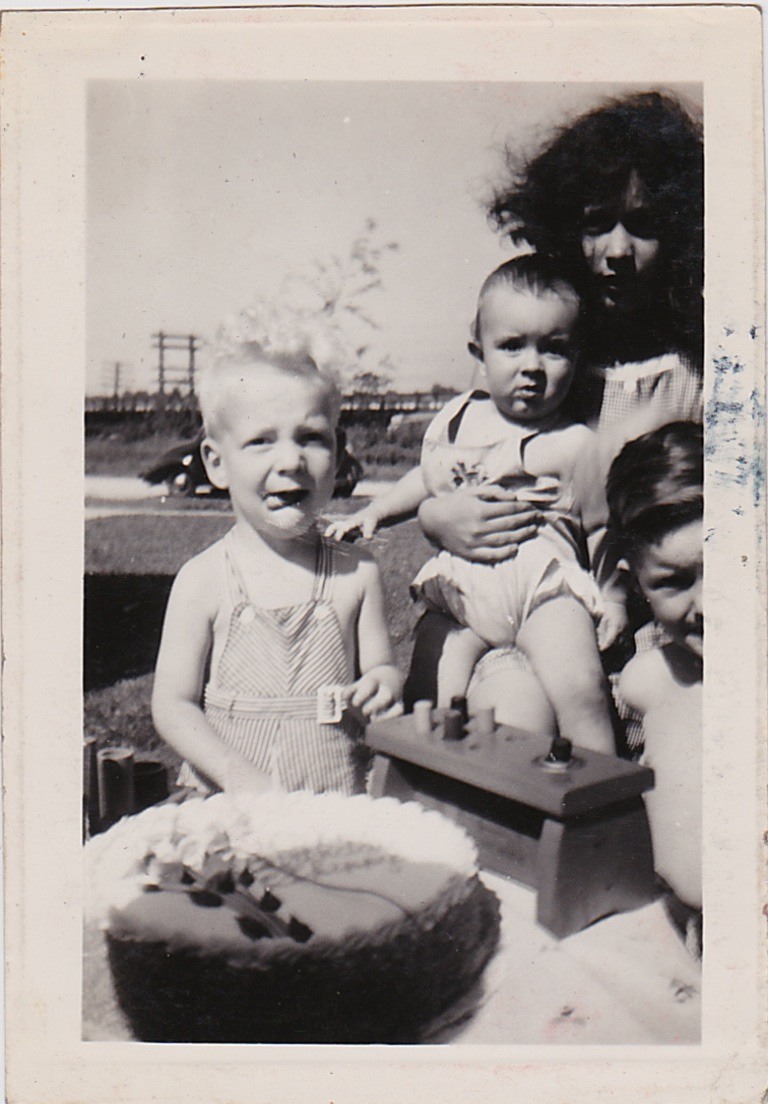
Grandma Wolff came up for a visit and I surprised her one day when I came home from the neighboring field with several baby garter snakes in my pocket! She had never seen anything like that before. It looks like she scolded me?
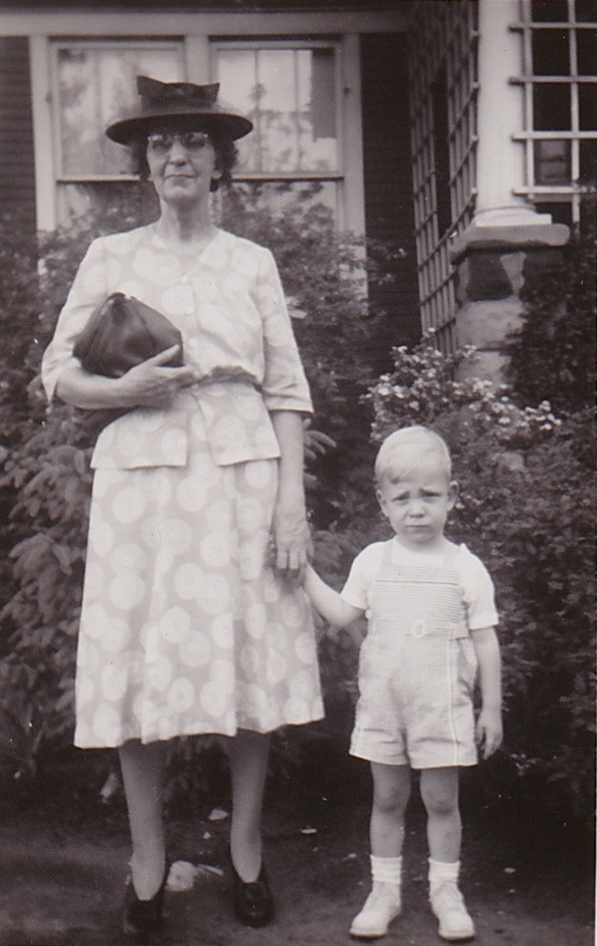
Grandpa Wolff was busy at home, adding a porch to the back apartment and, starting to convert the big two car garage into a garage apartment. Since he didn`t drive anymore, he figured it a waste just sitting there.
Soon, Christmas rolled around again and Grandpa and Grandma Barrett got a Pomeranian puppy and named her Dixie.
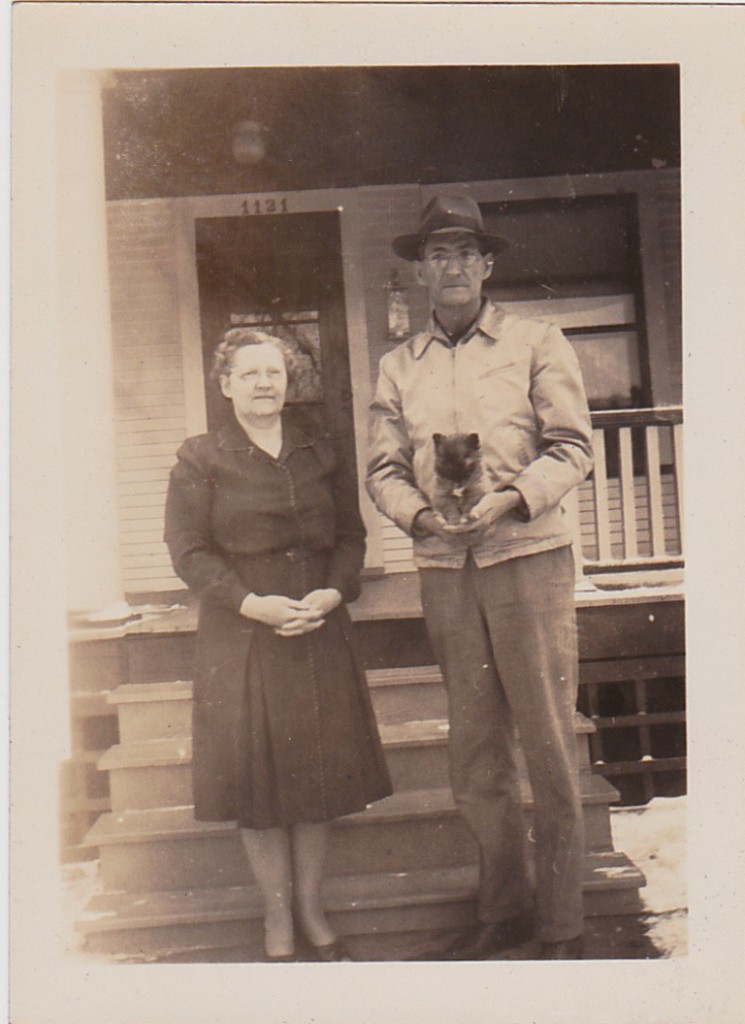
We had another tall tree for Christmas at our place in Munster.
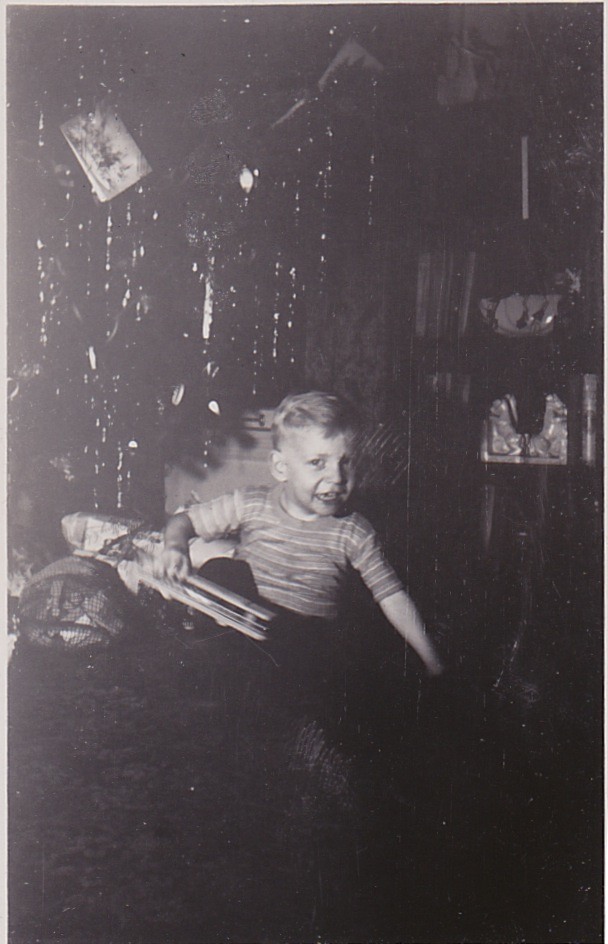
Grandma Wolff came up by train for a holiday visit.
During this time in Europe, the war was winding down and many allied military leaders thought troops might be going home for Christmas. But, Hitler had other plans.
The Battle of the Bulge (16 December 1944 – 25 January 1945) was a major German offensive campaign launched through the densely forested Ardennes region of Wallonia in Belgium, France, and Luxembourg on the Western Front toward the end of World War II in Europe. The surprise attack caught the Allied forces completely off guard. United States forces bore the brunt of the attack and incurred their highest casualties for any operation during the war. The battle also severely depleted Germany’s armored forces on the western front which Germany was largely unable to replace. German personnel and Luftwaffe aircraft also sustained heavy losses.
1945 SAW MANY GREAT CHANGES
1945
Sunday
April 1st
Two US Army and USMC divisions land along the southwest coast of Okinawa near Hagushi, meeting little resistance. The US 10th Army is commanded by Lieutenant General Simon Bolivar Buckner. Some 550,000 personnel and 180,000 soldiers take part in the fray.
1945
Thursday
April 5th
Allied forces find and locate the Japanese defenders along the southern portion of Okinawa. Heavy defenses are noted.
1945
Friday
April 6th
As American forces move further inland, the battle for Okinawa intensifies. Pockets of dug-in Japanese defenders become evermore concentrated the more inland the Allied forces go.
1945
Friday
April 6th
American forces are now amassed as two separate assault fronts. To the north are the 1st and 6th Marine divisions. To the mountainous south are the 7th and 96th Infantry divisions.
1945
Monday
April 16th
A five-day offensive is undertaken involving the American 77th Infantry Division and the island of Ie Shima. Ie Shima represents the tip of the Motobu Peninsula. Motobu is a defensive Japanese stronghold located to the west of Okinawa proper.
1945
Thursday
April 19th
Japanese defenders are pushed back towards Naha by American forces. The Japanese defensive lines are reset as territory is lost. The Americans report 1,000 casualties in their assaults.
Monday
April 20th
Adolf Hitler celebrates his final (56th) birthday, seemingly unaware of the fate to befall him and his Germany.
During the spring of 1945, with the demand for war materials dwindling, the plants were cutting their workforces. Luckily about this time, Dad`s brother, who owned an engraving shop in Anderson, offered him an apprenticeship in photo engraving. So, we packed up and moved into Grandpa`s garage apartment, as Dad`s brother was renting the upstairs apartment. We got a Beagle puppy for Easter!
Mother went back to work for the Chamber of Commerce. But, this time as a private secretary to the president, thanks to her experience working at the Dodge Plant!
Victory in Europe was achieved on May 8, 1945!

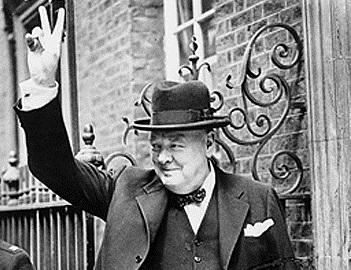
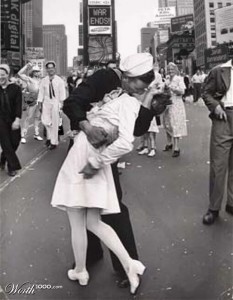
The eighth of May spelled the day when German troops throughout Europe finally laid down their arms: In Prague, Germans surrendered to their Soviet antagonists, after the latter had lost more than 8,000 soldiers, and the Germans considerably more; in Copenhagen and Oslo; at Karlshorst, near Berlin; in northern Latvia; on the Channel Island of Sark–the German surrender was realized in a final cease-fire. More surrender documents were signed in Berlin and in eastern Germany.
A little over a month later, June 27, Grandpa Wolff retired from the Gospel Trumpet Company. He noted in his journal, “June 27-Quit work at the Gospel Trumpet Co. Anderson, Ind. Retired on $44.00 per month from G.T.Co.(that was $1.00 per year of service) and 31.00 per month from Social Security-#305-10-xxxx.” Note that back then there was no concern about displaying your Social Security number. After 44 years working for the Gospel Trumpet, that was the final entry in his journal!
He started a new business in his basement workshop for bookbinding and repairing bibles. He would quickly gain a loyal following among the Church of God missionaries from around the world!
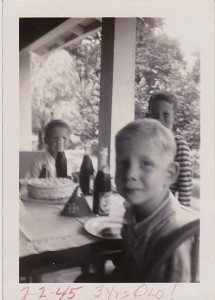
July 2,1945, we celebrated my birthday back on High Street in Park Place. Grandpa had added the porch to the rear-side of the house for the rear apartment and it made a nice party area! The photo below shows the garage apartment in the background. But, we were not going to live there for very long!
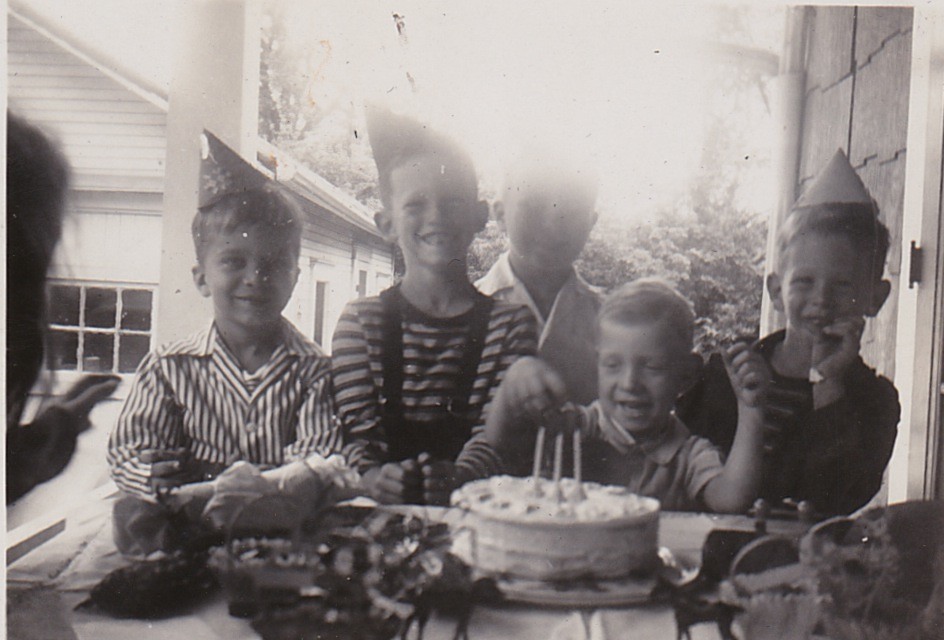
This is my Gene Autry outfit I got for my birthday. I loved cowboys and western wear!
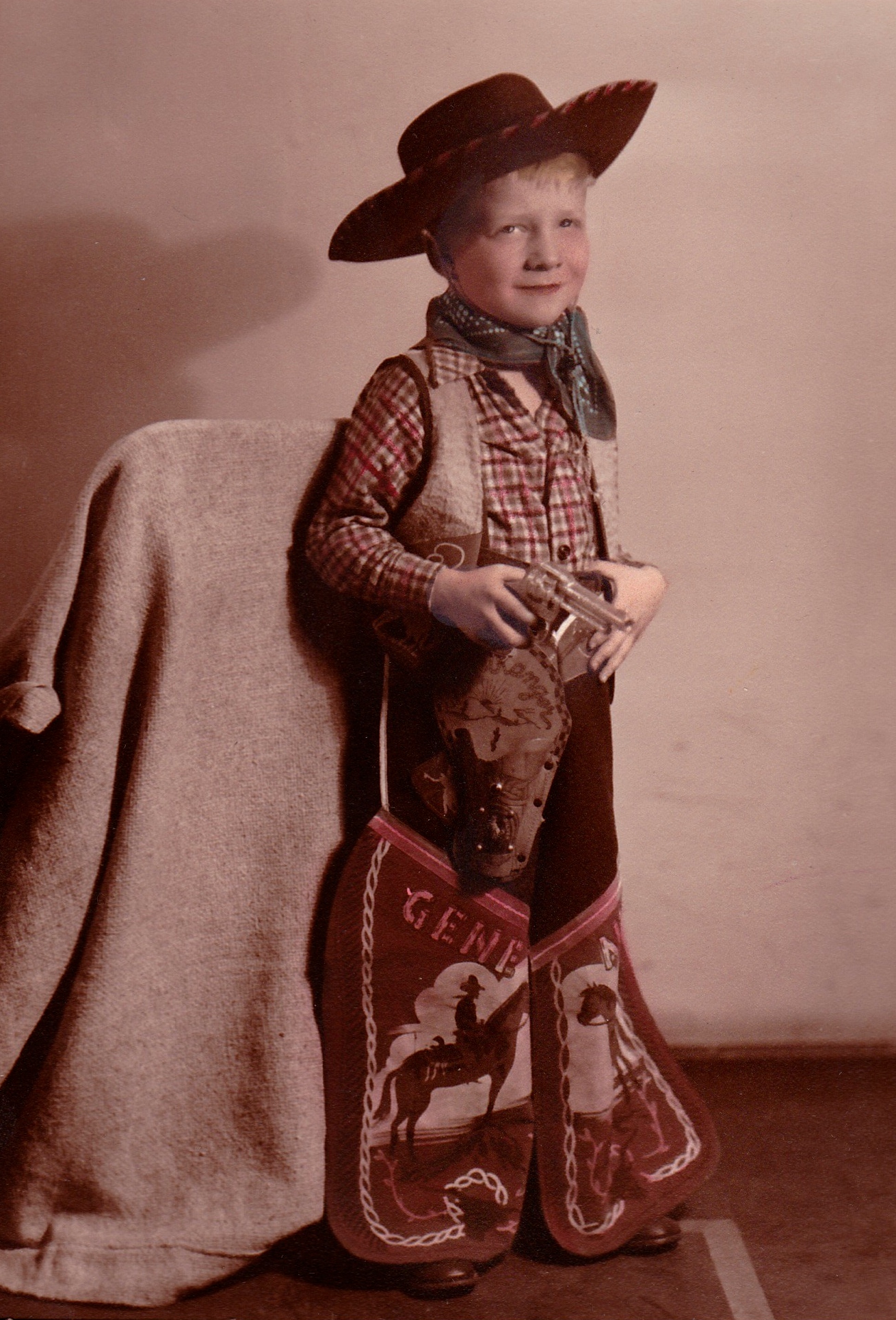
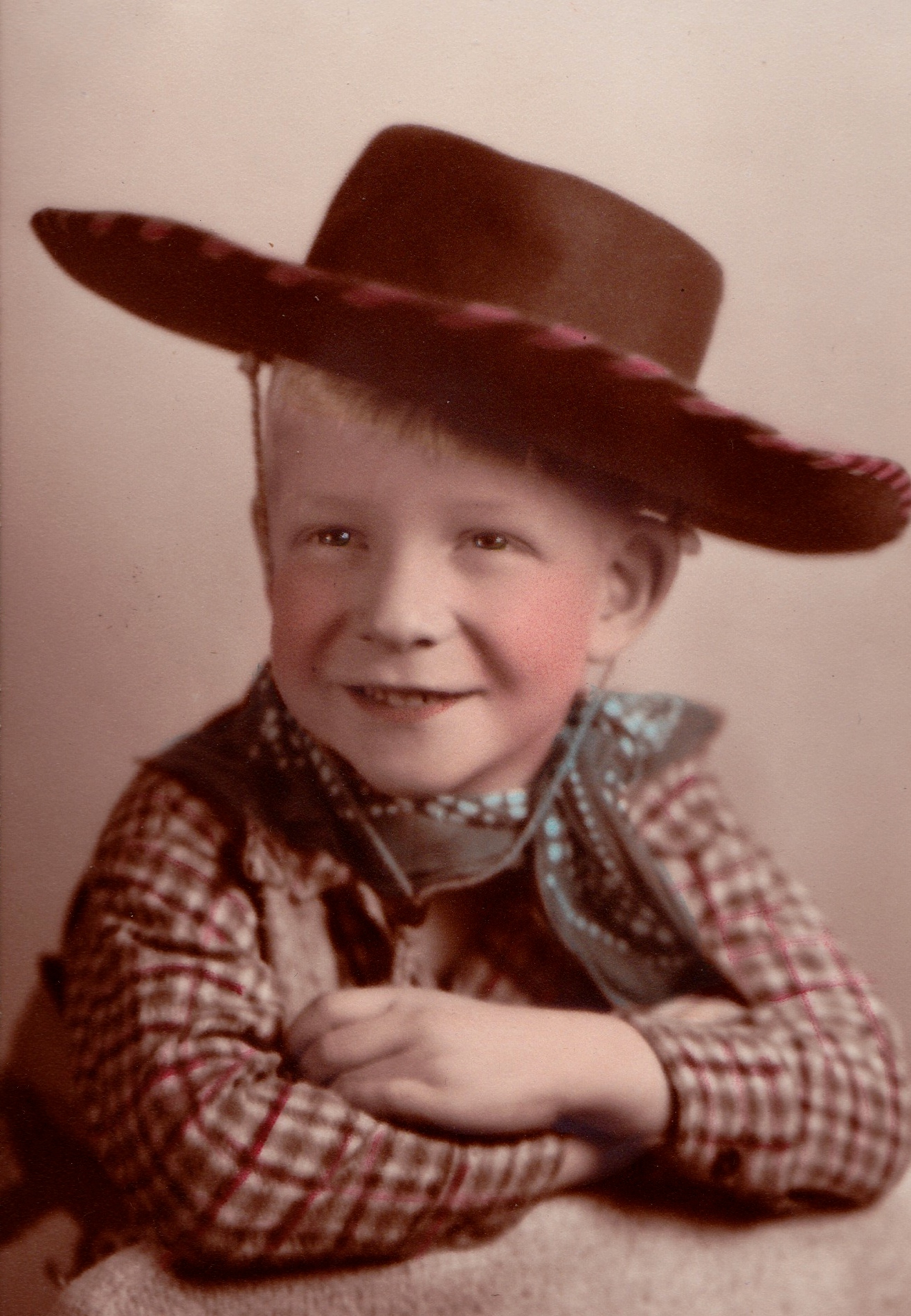
On August 6 the U.S. dropped a uranium gun-type atomic bomb (Little Boy) on Hiroshima. American President Harry S. Truman called for Japan’s surrender 16 hours later, warning them to “expect a rain of ruin from the air, the like of which has never been seen on this earth.” Three days later, on August 9, the U.S. dropped a plutonium implosion-type bomb (Fat Man) on the city of Nagasaki.
On August 15, six days after the bombing of Nagasaki and the Soviet Union’s declaration of war, Japan announced its surrender to the Allies. On September 2, it signed the instrument of surrender, effectively ending World War II. The bombings’ role in Japan’s surrender and their ethical justification are still debated.

On August 15, 1945, news of the surrender was announced to the world. This sparked spontaneous celebrations over the final ending of World War II.
On September 2, 1945, a formal surrender ceremony was held in Tokyo Bay aboard the USS Missouri. At the time, President Truman declared September 2 to be VJ Day.
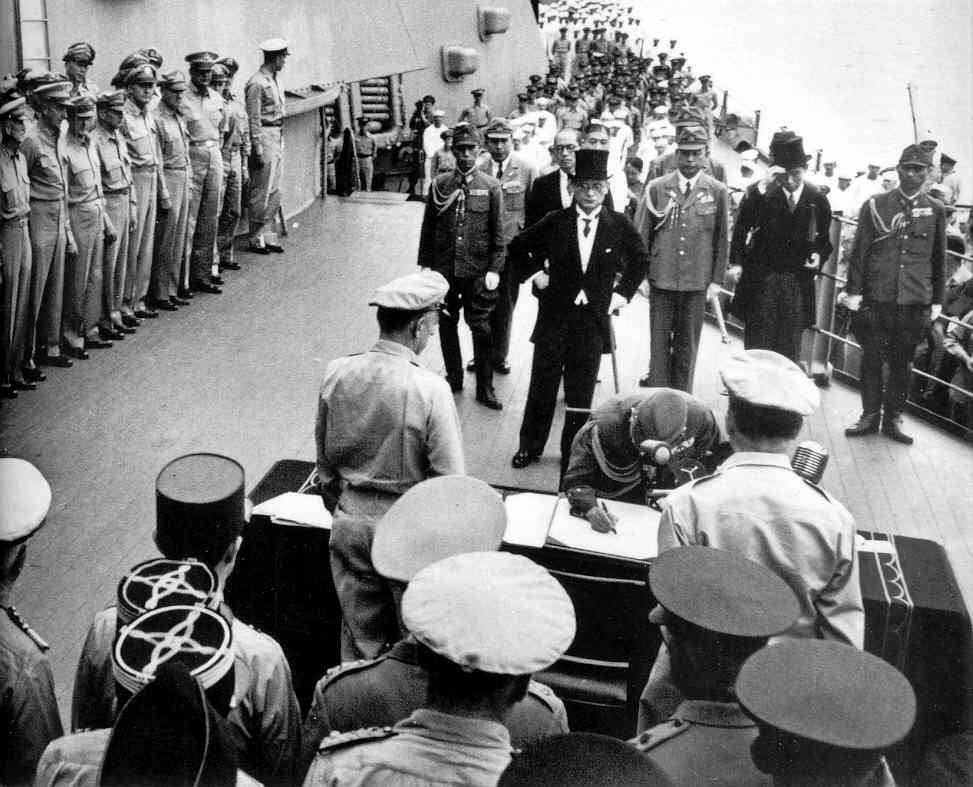
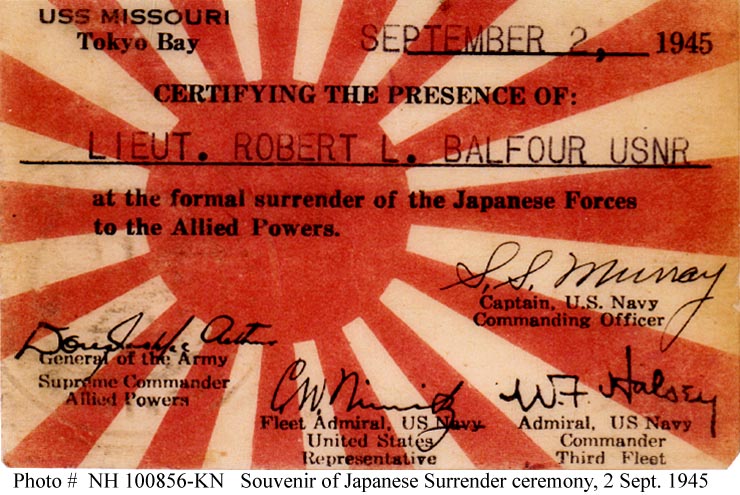
I didn`t comprehend what had happened but, I knew what a celebration was so I joined in!
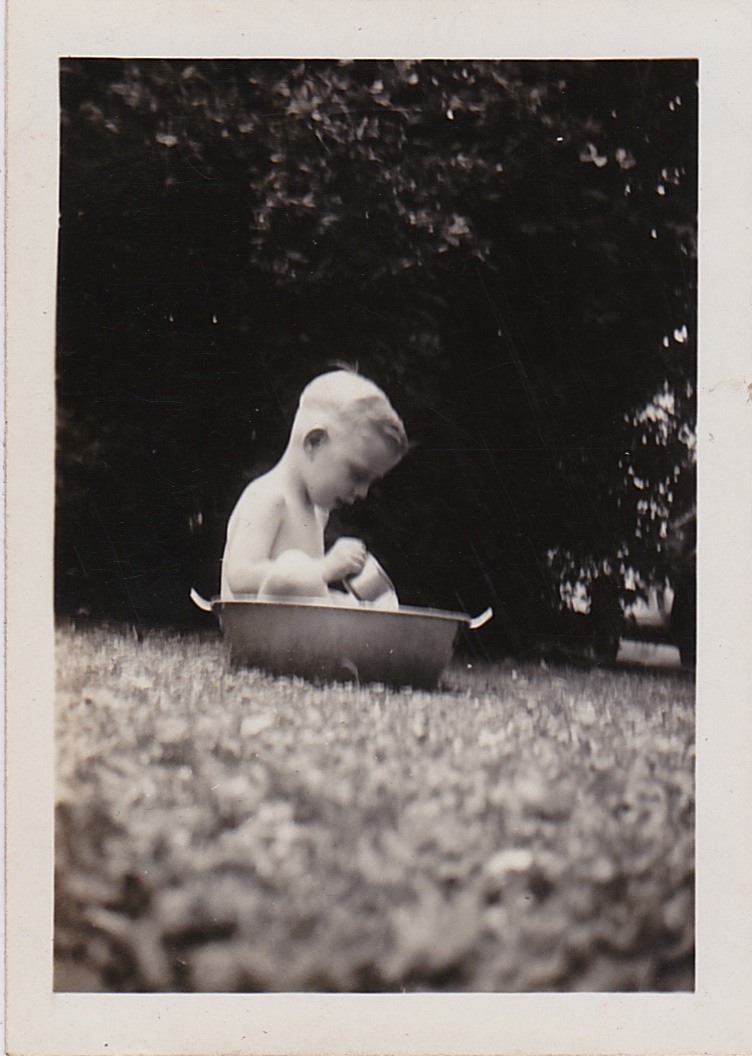
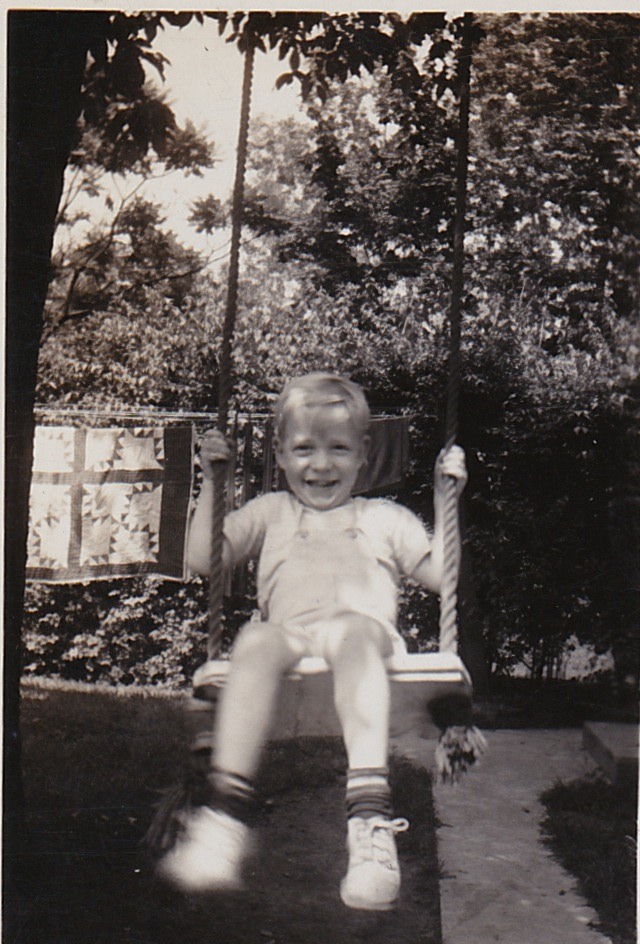
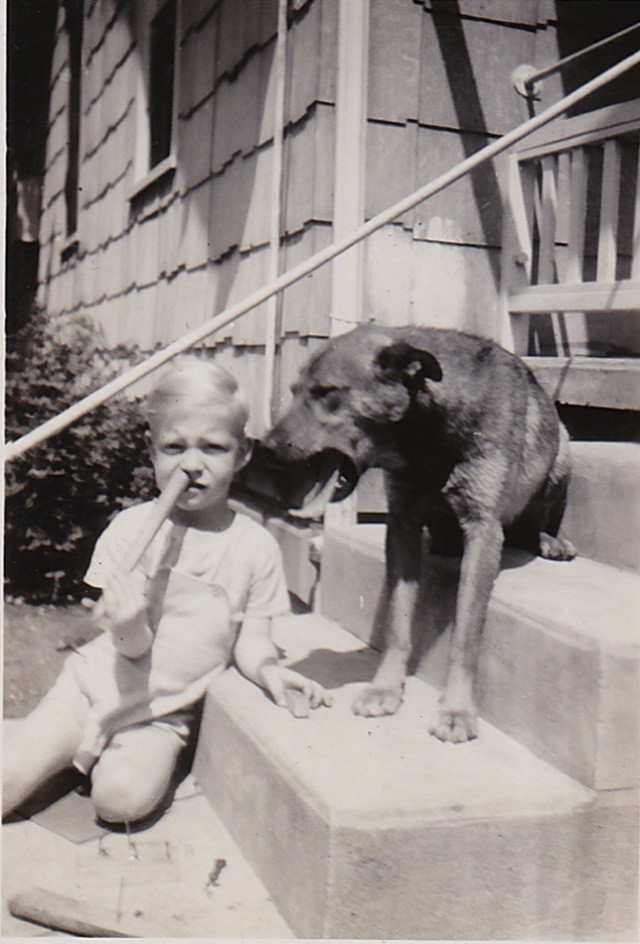
I was getting ready to “explode” a roll of caps in celebration! Watch out Dog!
A few days later, we went to the Soldiers and Sailors Monument in Indianapolis to celebrate. The war was over and we were ready to start a new chapter in our adventures of THE WOLFF`S DEN!
